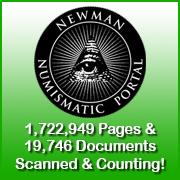
About UsThe Numismatic Bibliomania Society is a non-profit organization devoted to the study and enjoyment of numismatic literature. For more information please see our web site at coinbooks.org SubscriptionsThose wishing to become new E-Sylum subscribers (or wishing to Unsubscribe) can go to the following web page link MembershipThere is a membership application available on the web site Membership Application To join, print the application and return it with your check to the address printed on the application. Print/Digital membership is $40 to addresses in the U.S., and $60 elsewhere. A digital-only membership is available for $25. For those without web access, write to: Terry White, Treasurer AsylumFor Asylum mailing address changes and other membership questions, contact Terry at this email address: terrywhite5475@yahoo.com SubmissionsTo submit items for publication in The E-Sylum, just Reply to this message, or write to the Editor at this address: whomren@gmail.com BUY THE BOOK BEFORE THE COINSale Calendar |
- WAYNE'S WORDS: THE E-SYLUM MARCH 7, 2018
- ASYLUM SPRING 2018 ISSUE PUBLISHED
- NBS PRESIDENT'S SPRING 2018 MESSAGE
- NBS BENEFIT AUCTION AT 2018 ANA CONVENTION
- NEW BOOK: EX NUMMIS LUX
- NEW BOOK: KOLBE & FANNING 2017 SALES
- NEW BOOK: 2018 STANDARD CATALOG OF WORLD COINS, 1901-2000
- NEW BOOK: THE BANKNOTE BOOK: ITALY
- NEW BOOK: PAPER MONEY OF SCOTLAND
- A BOOK ON VIETNAMESE AND FRENCH COLONIAL COINS
- ANS LIBRARY ACQUISITIONS JANUARY 2018
- BURNS MEMORIAL REFERENCE LIBRARY DONATION
- THE NEWMAN PORTAL AND BORN-DIGITAL CONTENT
- NEWMAN PORTAL SEARCH: SIMON BOLIVAR MEDAL
- ROBERT COULTON DAVIS PHOTOS
- COLONIAL-ERA DOLLARS AND UNITS OF ACCOUNT
- NOTES FROM E-SYLUM READERS: MARCH 4, 2018
- VIEWING COINS OBLIQUELY
- DESIGN OF THE 2018 WINTER OLYMPIC MEDALS
- VOCABULARY TERMS RELATING TO DIE WEAR
- GEORGE EAVENSON (1854-1912)
- PROFILE: BANKNOTE COLLECTOR HAKKEEM MALIEKKAL
- THE FREEDMAN'S BANK
- ANA MONEY MUSEUM AND LIBRARY VIRTUAL TOUR
- ANS COINS FEATURED IN MUSEUM EXHIBITS
- NATIONAL HELLENIC MUSEUM EXHIBIT
- LONG BEACH “SHIP OF GOLD” EXHIBIT
- NUMISMATIC NUGGETS: MARCH 4, 2018
- MEDAL SELECTIONS FROM NUMISMAGRAM: POWER STRUGGLES
- TEXAS JOLAS OFFERED IN KAGIN'S MARCH 2018 SALE
- SELECTIONS FROM HOLABIRD MARCH 2018 SALE
- ARCHIVES INTERNATIONAL SALE #47 ANNOUNCED
- RETAINING EQUITY IN NUMISMATICS
- 15TH CENTURY COIN HOARD FOUND NEAR DUTCH CITY
- THE ROYAL MINT'S NEW 10-PENCE COINS
- VIDEO: 1940S PHILADELPHIA MINT
- LORD ASHCROFT ACQUIRES SIDNEY DAY VICTORIA CROSS
- ISRAELI GROUP MINTS TRUMP JERUSALEM MEDAL
- MOVIE MONEY: THE BANKNOTES OF ZAMUNDA
- IN OTHER NEWS: MARCH 4, 2018
- FEATURED WEB SITE: MINT OF FINLAND
Click here to access the complete archive
To comment or submit articles, reply to whomren@gmail.com
Content presented in The E-Sylum is not necessarily researched or independently fact-checked, and views expressed do not necessarily represent those of the Numismatic Bibliomania Society.
WAYNE'S WORDS: THE E-SYLUM MARCH 7, 2018
 This week we open with updates from the Numismatic Bibliomania Society, five new books and more. Other topics this week include Robert Coulton Davis, the 2018 Winter Olympic medal design,
die wear, the ANA Money Museum and multiple other museum exhibits, Texas jolas, the new 10 pence coins, and the Philadelphia Mint in the 1940s. Also: Which fictional African nation has its own
banknotes: Wakanda, Wakonda, Wauconda or Zamunda?
This week we open with updates from the Numismatic Bibliomania Society, five new books and more. Other topics this week include Robert Coulton Davis, the 2018 Winter Olympic medal design,
die wear, the ANA Money Museum and multiple other museum exhibits, Texas jolas, the new 10 pence coins, and the Philadelphia Mint in the 1940s. Also: Which fictional African nation has its own
banknotes: Wakanda, Wakonda, Wauconda or Zamunda?
To learn more about the banknotes of Italy and Scotland, Simon Bolivar medals, coin-collecting Presidents, the Freedman's Bank, Medusa coins, the Ship of Gold exhibit, the Bermuda Hog Penny Pub, Hart's "Coins of the West", and the Trump Jerusalem medal, read on. Have a great week, everyone!
Wayne Homren
Editor, The E-Sylum
ASYLUM SPRING 2018 ISSUE PUBLISHED
The Asylum
Spring 2018 Issue Vol. 36 No. 1
Table of Contents:
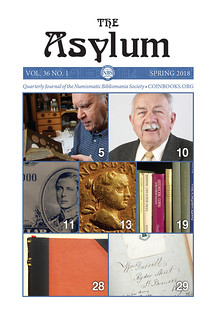 Message from the President
Message from the President
Tom Harrison
NBS Receives Generous Donation from EPNNES
Eric P. Newman 1911–2017: Vignettes from a Life Extraordinary
Joel J. Orosz
A Tribute to Eric P. Newman
Peter Gaspar
Phil Carrigan: Some Recollections
David F. Fanning
Unissued Edward VIII Notes Highlight Regina Coin Show
George Manz, FRCNA
On the Countermarked Ancient Coins from the Collection of Alphonso II d’Este
Hadrien J. Rambach
Buy the Book for the Coin: Books for the Byzantine Coin Collector
Michael Shutterly
A Beautiful, Well-Traveled Coin Book with a Long Title
Norman J. Cochrane
A Well-Noted Numismatic Book by John Yonge Akerman
David Pickup
To join NBS or renew your annual membership, see:
http://www.coinbooks.org/about/membership.html
NBS PRESIDENT'S SPRING 2018 MESSAGE
Message from the President
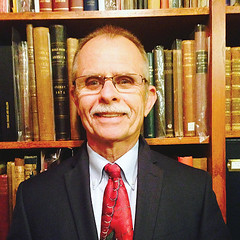 I am pleased to announce the Numismatic Bibliomania Society is the honored recipient of a very generous donation from the Eric P. Newman Numismatic Education Society. This windfall will
help bolster our financial health as we continue our mission to promote the appreciation and preservation of numismatic literature that was the foundation of Mr. Newman’s research and discovery. We
will endeavor to sustain the legacy of Eric P. Newman, a numismatic luminary, who inspired many of our members to emulate the benchmark he established over his nearly one hundred years immersed in
the world of numismatics. The NBS is sincerely grateful for this thoughtful gesture that will enhance the entire numismatic literature community.
I am pleased to announce the Numismatic Bibliomania Society is the honored recipient of a very generous donation from the Eric P. Newman Numismatic Education Society. This windfall will
help bolster our financial health as we continue our mission to promote the appreciation and preservation of numismatic literature that was the foundation of Mr. Newman’s research and discovery. We
will endeavor to sustain the legacy of Eric P. Newman, a numismatic luminary, who inspired many of our members to emulate the benchmark he established over his nearly one hundred years immersed in
the world of numismatics. The NBS is sincerely grateful for this thoughtful gesture that will enhance the entire numismatic literature community.
As we turn the calendar to 2018, it is not too early to begin planning for our annual events at this year’s ANA World’s Fair of Money in Philadelphia. We hope many of you will be able to join your fellow NBSers at our Symposium and General Meeting to connect with old friends and make new acquaintances.
The gathering provides several opportunities to share our enthusiasm and promote our fine hobby. The benefit auction held at the General Meeting is crucial to the financial health of the NBS. Whether you have an item valued at $25.00 or several hundred dollars, your donation will play a significant role in the success of your organization. Of course, the primary focus of the auction is to shore up our finances, while at the same time, striving to generate some fun. In an effort to spice up the auction, would you have an amusing, oddball, or novel item to contribute for the betterment of the NBS? It would be a notable sign of our vitality to see a wider pool of donors and bidders at this year’s event. Even if you are unable to join us in Philadelphia, please consider this all-important opportunity to support your NBS.
A numismatic literature exhibit is an excellent way to promote our hobby to the greater numismatic community. Your educational and eye-catching display could be the catalyst that inspires other numismatists to enrich their collection with the addition of related literature. With a registration deadline of June 15th, 2018, there is plenty of time to consider and create a fascinating exhibit for this year’s premier numismatic event.
As we look forward to 2018, please know that I, the NBS Board of Trustees and the entire numismatic literature community truly appreciate each member’s contribution. May your numismatic library provide investigation, discovery, and most of all, enjoyment.
NBS BENEFIT AUCTION AT 2018 ANA CONVENTION
Numismatic Bibliomania Society board member Len Augsburger writes: 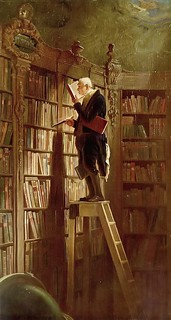
David Fanning has again graciously agreed to collect and catalog lots for the NBS Benefit Auction to be held at the ANA Convention in Philadelphia in August. Literature donations may be sent to David Fanning, 141 W. Johnstown Road, Gahanna OH 43230. Suggested lot value is $100 and up, but all donations will be accepted. Highlights from last year’s sale include a leatherbound copy of Neil Musante’s The Medallic Work of John Adams Bolen (donated by Dan Hamelberg), and a modern plated reprint of Henry Chapman’s 1918 Bement sale (donated by George Kolbe). A catalog will be compiled and distributed prior to the auction.
The previous (2017) NBS Benefit Auction sale catalog, prepared by David Fanning can be seen here:
https://nnp.wustl.edu/library/auctionlots?AucCoId=512295&AuctionId=518568
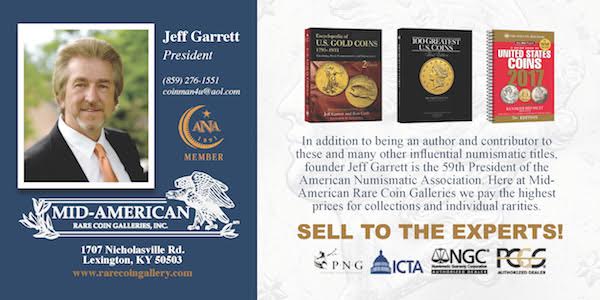
NEW BOOK: EX NUMMIS LUX
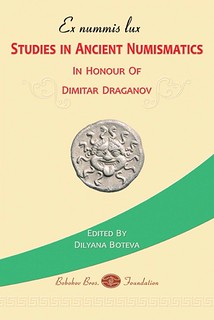 EX NUMMIS LUX: STUDIES IN ANCIENT NUMISMATICS IN HONOUR OF DIMITAR DRAGANOV.
EX NUMMIS LUX: STUDIES IN ANCIENT NUMISMATICS IN HONOUR OF DIMITAR DRAGANOV.
Boteva, Dilyana [editor].
Sofia: Bobokov Brothers Foundation, 2017. 4to, original pictorial boards. 479, (1) pages; illustrated in color. New. Item #4857
A new feschrift published in honor of Bulgarian numismatic researcher Dimitar Draganov, who has published widely on ancient coins. Includes 36 articles, a bibliography of Draganov’s works, a preface, and a tribute essay by Ursula Kampmann. Most of the essays are in English, with a few each in French and German and two in Italian. The emphasis is on ancient Greek and Roman provincial coins of Asia Minor and Macedonia.
For more information, or to order, see:
EX NUMMIS LUX: STUDIES IN ANCIENT NUMISMATICS IN HONOUR
OF DIMITAR DRAGANOV. (https://www.numislit.com/pages/books/4857/dilyana-boteva/ex-nummis-lux-studies-in-ancient-numismatics-in-honour-of-dimitar-draganov)
NEW BOOK: KOLBE & FANNING 2017 SALES
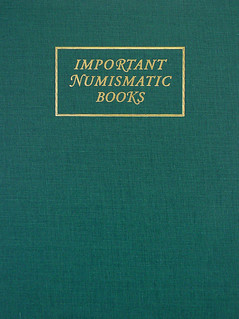 2017 MAIL BID SALES 145, 146 AND 147. IMPORTANT NUMISMATIC LITERATURE.
2017 MAIL BID SALES 145, 146 AND 147. IMPORTANT NUMISMATIC LITERATURE.
Kolbe & Fanning.
Gahanna: 2017. Three mail bid sales bound in one volume. SALE 145. April 22, 2017. 72 pages; 443 lots. [bound with] SALE 146. July 15, 2017. 68 pages; 400 lots. [bound with] SALE 147. October 7, 2017. 78 pages; 499 lots. 4to, original green cloth, gilt; original pictorial card covers bound in. PRLs bound in. New. Item #4898
Features selections from the libraries of William A. Burd, Italo Vecchi, Tom Cederlind and Q. David Bowers.
For more information, or to order, see:
2017 MAIL BID SALES 145, 146 AND 147. IMPORTANT NUMISMATIC
LITERATURE. (https://www.numislit.com/pages/books/4898/kolbe-fanning/2017-mail-bid-sales-145-146-and-147-important-numismatic-literature)
NEW BOOK: 2018 STANDARD CATALOG OF WORLD COINS, 1901-2000
2018 Standard Catalog of World Coins, 1901-2000
45th Edition
By Thomas Michael
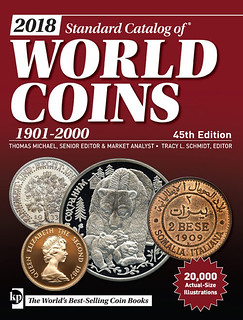 Massive in scope and encyclopedic in detail, the 2018 Standard Catalog of World Coins, 1901-2000, 45th edition, provides the most comprehensive reference to 20th century coins on the
market.
Massive in scope and encyclopedic in detail, the 2018 Standard Catalog of World Coins, 1901-2000, 45th edition, provides the most comprehensive reference to 20th century coins on the
market.
This tradition-rich catalog is vetted by experts worldwide, providing a global view of the most passionately collected and popular segment of numismatics. Based on the early work of numismatic giants Chester L. Krause and Clifford Mishler, the Standard Catalog is the reference of choice for beginning or serious collectors, researchers, and coin dealers specializing in 20th century coins.
In the current market, with precious metals stable, collectible coin values have settled in to reasonable levels, driving careful collectors to seek out the highest grade coins available. This continuing interest in high-grade, exceptional coins is reflected in the catalog, which now offers more and better-defined values for many countries.
Extensive yet easily managed, the catalog is organized by country and features:
- 60,000 actual-size images
- Universally used KM reference numbers
- Clear descriptions with invaluable detail
- Current values for coins listed by date, mintmark, and grade
$70
For more information, or to order, see:
2018 Standard Catalog of World Coins, 1901-2000
(https://www.shopnumismaster.com/2018-standard-catalog-of-world-coins-1901-2000)
NEW BOOK: THE BANKNOTE BOOK: ITALY
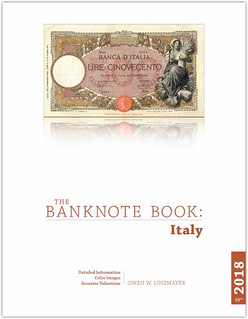 Buon giorno! I'm pleased to announce the Italy chapter is now available for individual sale at US$9.99, and as a free download to subscribers.
Buon giorno! I'm pleased to announce the Italy chapter is now available for individual sale at US$9.99, and as a free download to subscribers.
Italy (Europe)
This 52-page catalog covers notes issued by the Consorzio degli Istituti di Emissione (Consortium of Issuing Institutes) in 1874, Biglietti Già Consorziale (Former Banknote Consortium) in 1881,
Ministero del Tesoro (Ministry of the Treasury) from 1882 to 1979, Banca d'Italia (Bank of Italy) from 1896 to 1997, Cassa Veneta dei Prestiti (Venetian Loan Office) in 1918, and Allied Military
Currency in 1943. Published 02.03.2018.
For more information, or to order, see:
http://banknotebook.contentshelf.com/shop
NEW BOOK: PAPER MONEY OF SCOTLAND
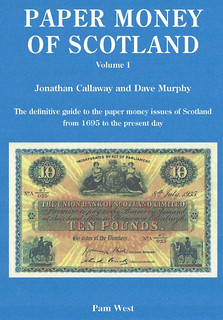 In her March 2nd 2018 newsletter A Bank Note Affair, publisher Pam West announced a new book:
In her March 2nd 2018 newsletter A Bank Note Affair, publisher Pam West announced a new book:
Paper Money of Scotland Vol 1 & II due to arrive early March. This two volume priced catalogue covers 1150 full colour pages weighs in at almost 3 kilos. Written by Jonathan Callaway and David Murphy with over 10 years of research, brings the fascinating story of the Scottish issues to light in this definitive guide. £50 for the two volumes, plus post.
For more information, or to order, see:
http://britishnotes.co.uk/
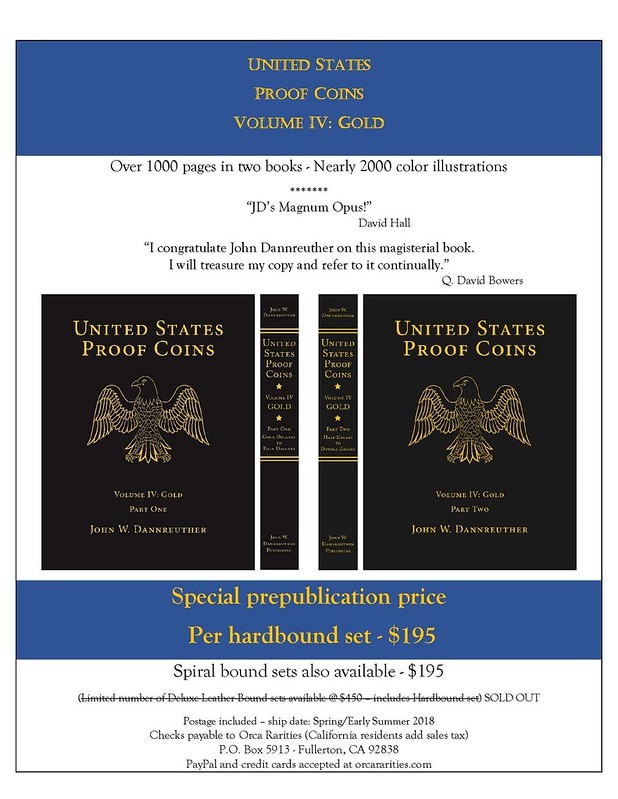
A BOOK ON VIETNAMESE AND FRENCH COLONIAL COINS
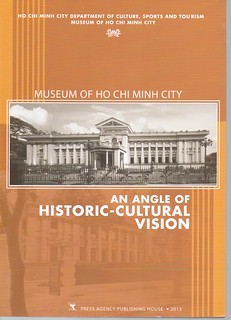 During my recent visit to Viet Nam I visited the Ho Chi Minh City Museum at 65 Ly Tu Trong in District 1. It has a numismatic exhibit room on the 2nd Floor. The numismatic curator is Ms Ha
Thi Thu Hien, who can be contacted at HaHienBTTP@gmail.com. She is a very modest lady and does not fully believe she is doing some significant numismatic
work in Viet Nam.
During my recent visit to Viet Nam I visited the Ho Chi Minh City Museum at 65 Ly Tu Trong in District 1. It has a numismatic exhibit room on the 2nd Floor. The numismatic curator is Ms Ha
Thi Thu Hien, who can be contacted at HaHienBTTP@gmail.com. She is a very modest lady and does not fully believe she is doing some significant numismatic
work in Viet Nam.
I first met Ms Thu Hien several years ago when she set up the first numismatic exhibits with pieces on loan from four or five advanced collectors who live in Ho Chi Minh City. Now, she told me the museum owns all of the pieces in the room. This is a significant accomplishment because many of the pieces are extremely rare to very scarce.
While looking through the museum's souvenir stand display cases, I found a book which includes numismatic information. Its title is An Angle of Historic-Cultural Vision by Chief Editors Master Pham Duong My Thu Huyen and Dr. Hoang Anh Tuan; published by Vu Quoc Khanh in Ho Chi Minh City, Vietnam, in 1973 with 95 pages. It has card covers with thick glossy pages and the images are in color.

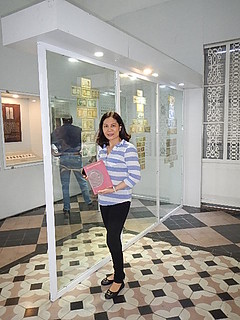
Sample page; Ms Ha Thi Thu Hien
The book has nine numismatic pages that illustrate and describe several of the important pieces, to include gold, silver and a printing plate. It is worth having in the library of a collector of Vietnamese and French colonial pieces. It can be purchased from Mr. Nguyen Ngoc Viet, who can be contacted at Viet@UEH.edu. Mr. Viet is an old friend who has assisted me in printing some of my past catalogs. He is planning to sell many numismatic and philatelic books on his website.
For more on the Museum of Ho CHi Minh City, see:
http://www.hcmc-museum.edu.vn/en-us/
ANS LIBRARY ACQUISITIONS JANUARY 2018

To read the complete list, see:
New Acquisitions - January 2018
(https://donum.numismatics.org/cgi-bin/koha/opac-shelves.pl?op=view&shelfnumber=133)
BURNS MEMORIAL REFERENCE LIBRARY DONATION
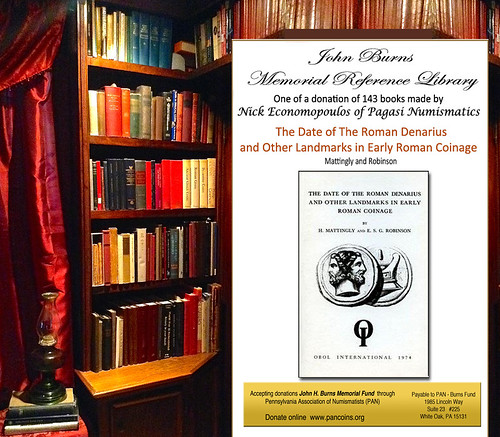
PAN had a very unexpected and pleasant surprise when coin dealer Nick Economopoulos backed his vehicle to the loading dock to unload and set up at the past October PAN coin show. He asked if we could give him a hand unloading bags of 143 various books that he brought to donate to our John Burns Reference Library that we have set up at all the PAN shows.
Nick is the director of the East Coast Pennsylvania Office of Pegasi Numismatics. He holds advanced degrees in Classics and Classical Archaeology and has been a numismatist for 37 years. Nicholas heads the wholesale division of Pegasi and attends every major coin show in the United States. He specializes in all facets of Ancient coinage and is an authority on the coinage of the Byzantine Empire.
He told us that he was doing a little house cleaning and decided to go the donation route instead of selling the books. We have now entered all of them into our library inventory. The list can be viewed on our PAN website, Burns Library page. If you are unfamiliar about the use and purpose of this library then please go to the page and read more. These donated books will be part of the set up for the PAN Spring Coin show. We now have added another set of bookshelves to house our growing collection. We currently have 363 books in the library inventory.
For more information on the Burns library, see:
John Burns Memorial Reference Library (https://pancoins.org/john-burns-memorial-reference-library/)
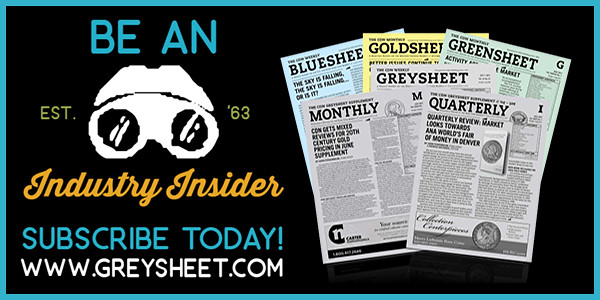
THE NEWMAN PORTAL AND BORN-DIGITAL CONTENT
 As the print v. digital question evolves, more and more content is being produced in digital form only and never reaches print. Although world print production is somewhat steady (declining
in advanced economies, and increasing in growth economies such as India, China, Brazil), the creation of born-digital content continues to explode and shows no signs of abating. The Newman Portal
increasingly acquires numismatic content electronically as opposed to physically scanning each document.
As the print v. digital question evolves, more and more content is being produced in digital form only and never reaches print. Although world print production is somewhat steady (declining
in advanced economies, and increasing in growth economies such as India, China, Brazil), the creation of born-digital content continues to explode and shows no signs of abating. The Newman Portal
increasingly acquires numismatic content electronically as opposed to physically scanning each document.
One such recent addition are the electronic letters of Rich Uhrich Rare Coins. A longtime executive with Hershey, Uhrich exited the corporate world and launched a rare coin dealership in the mid-2000s. Uhrich periodically issued an electronic newsletter from 2008 to 2018, typically commenting on his market specialties, in particular U.S. bust and seated silver coinage. In recent years his annual “Coin Year in Review” edition has offered a well-crafted, humorous view of the numismatic world. In December 2013 he noted “MOST UNUSUAL NEW COIN – ‘Bitcoins’ are virtual currency created by a computer. No, I don’t understand them either.”
Uhrich recently announced his retirement from the rare coin business and offered these newsletters to NNP, where they will serve as a permanent record of this slice of the numismatic market. Newman Portal also hosts newsletters of other dealers (such as Shanna Schmidt Numismatics, Sunshine Rare Coins, etc.) and invites wider participation. Typically all that is needed is permission to do so, as Newman Portal can acquire this content directly from the Internet with no personal interaction required.
Link to Rich Uhrich newsletters on Newman Portal:
https://nnp.wustl.edu/library/publisherdetail/524331
Link to Shanna Schmidt Numismatics on Newman Portal:
https://nnp.wustl.edu/library/publisherdetail/518823
Link to Sunshine Rare Coins on Newman Portal:
https://nnp.wustl.edu/library/publisherdetail/521883
NEWMAN PORTAL SEARCH: SIMON BOLIVAR MEDAL
Newman Portal Search: Simon Bolivar, Three Countries, Three Medals
This week a Newman Portal user searched for “Simon Bolivar Medal.” Wikipedia provides the context. Bolivar (1783-1830), “also colloquially [known] as El Libertador, was a Venezuelan military and political leader who played a leading role in the establishment of Venezuela, Bolivia, Colombia, Ecuador, Peru, and Panama as sovereign states, independent of Spanish rule.” It’s no surprise that contemporary medallic tributes honor such a leader, and Newman Portal can be used to identify three of them.
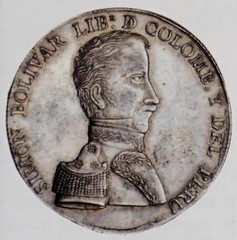
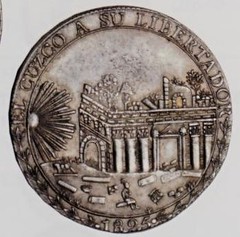
Stack’s George Gund III sale catalog, January 15, 2007 , lot 3267 (realized $1,035)

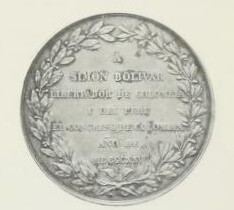
Almanzar’s Medina sale catalog, April 12, 1971, lot 179
Another example, from Colombia, is found in the Medina collection sold by Almanzar’s in April, 1971, lot 179. This features two angels on the obverse with the inscriptions A / SIMON BOLIVAR / LIBERTADOR DE COLOMBIA / Y DEL PERU / EL CONGRESO DE COLOMBIA / ANO DE / MDCCCXXV.
Finally, a third Bolivar medal is listed in the Johnson & Jensen sale of December 1978, lot 224. Johnson catalogs it as Bolivian, “1825, 1 5/8-inch (42mm) bronze, reeded edge. City of Potosi shows its gratitude to the Liberator. Uniformed bust facing right, inscription around border. So-called proclamation piece.” Such pieces are akin to those honoring American revolutionary heroes, and offer a way to “collect history” for substantially less funds than the American equivalents.
Link to Stack’s Gund III catalog on NNP:
https://nnp.wustl.edu/library/auctionlots?AucCoId=3&AuctionId=517511&page=66
Link to Almanzar’s Medina sale catalog:
https://nnp.wustl.edu/library/auctionlots?AucCoId=510226&AuctionId=518415&page=26
Link to Johnson & Jensen December 1978 sale:
https://nnp.wustl.edu/library/auctionlots?AucCoId=511036&AuctionId=518008&page=13
ROBERT COULTON DAVIS PHOTOS
Regarding last week's mystery numismatist sporting a coin stickpin, Pete Smith writes:
For the February 25, 2012, issue of The E-Sylum, I submitted a photograph of a mystery Numismatist. By the next week no one had identified Robert Coulton Davis. There was a later E-Sylum request from Heritage for a photo of Davis and I was able to provide it.
You wouldn't try to fool us again with an older photo of Davis, would you?
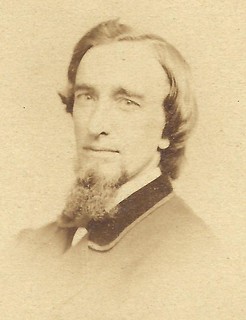

To read the earlier E-Sylum articles, see:
QUIZ ANSWER: ROBERT COULTON DAVIS (http://www.coinbooks.org/esylum_v15n10a08.html)
MYSTERY NUMISMATIST WITH A COIN STOCKPIN (http://www.coinbooks.org/v21/esylum_v21n08a18.html)

COLONIAL-ERA DOLLARS AND UNITS OF ACCOUNT
Martin Purdy
Martin Purdy of New Zealand writes:
In all likelihood, the dollar (Spanish dollar, remember) would still have been tariffed in shillings and pence in 1780, so there's no clash of units here. I find several references on-line to the different states having varying tariffs for the Spanish dollar in shillings - ranging from 6s to 7s6d and even 8s in New York. Others may correct me, but I thought "cents" only started in the later 1780s - shillings and pence would have been current before then, at least as units of account.
And in the UK, a "dollar" was slang for 5 shillings right through to decimalisation in 1971 (particularly in the expression "half a dollar", meaning a half-crown coin, which was a circulating piece, unlike the crown in later decades at least). The Brits also had the "Bank of England Dollar" in 1804 which, as far as I know, is the only UK coin to actually carry that word - it was overstruck on Spanish dollars so it made sense to retain the term.
For reference, see: https://coins.nd.edu/ColCurrency/FAQ/cc-notesinfo.html .
Steve Feller
Steve Feller writes:
A long while ago I wrote an article for Paper Money on the interest payments indicated on each state note of the 1780 series. I analyzed each state and quickly found out that the different states had different exchange rates of Spanish dollars into English money. This is well-known but the calculation by state was enlightening. The reference is: S.A. Feller, “A Rhode Island note, Spanish milled dollars, and English shillings,” Paper Money 111 (1984) 131.
I used the wonderful book by Eric Newman--The Early Paper Money of America that was published in 1976. Later on I upgraded to the fifth edition of this great book.
Chip Howell

Chip Howell writes:
the pre-decimal British currency was known as the "£sd" system. So when I saw this, by the order I knew the "q" must be smaller than a penny. What I wonder is, 12 x 2½ = 30 farthings, which would be 0.7.2 (s.d.q). I have to wonder--where is the missing farthing? Is it a discount for paying a year in advance? More likely, it's just a rounding convention: squeezing an extra 1/48th of a penny (1/11,520 of a pound) out of a debtor each month, cannot qualify as a "get rich quick" scheme.
Ron Haller-Williams
Ron Haller-Williams writes:
If, as indicated in Wikipedia, the Spanish-American peso of 8 reales ("Spanish milled dollar") was tariffed at exactly 6 shillings (£0.30) in Virginia, then the annual interest of 5% on two pesos would be 28.8 farthings (almost 7 pence and 1 farthing), while the monthly equivalent would be 2.4 farthings (almost 2½ farthings).
Maybe the promise of payment in those silver coins was because of the inflation/devaluation associated with the "continental currency"?
Pesos, with their halves (4 reales) and quarters (2 reales) were plentiful for larger values, while British copper coins, perhaps alongside local tokens, were still fairly plentiful for small values. However, Britain hadn't yet introduced the half farthing (this was in 1828, at first for use in Ceylon), although such a coin is mentioned in the Bible - Mark 12:42.
The U.S. dollar was first defined by the Coinage Act of 1792 and was introduced later that year - twelve years after this note was issued.
References:
United States dollar : Continental currency
(https://en.wikipedia.org/wiki/United_States_dollar#Continental_currency)
Early American currency : Continental currency
(https://en.wikipedia.org/wiki/Early_American_currency#Continental_currency)
Ron adds:
Further to the UK angle mentioned by Martin Purdy:
• In rhyming slang, an "oxford" (in full, "Oxford scholar") was a half-crown (two shillings and sixpence), or "half a dollar".
• The "Bank of England Dollar" (worth 5 shillings) dated 1804 was made by restriking Spanish-American 8 reales coins; some details of the original coin are often visible, proving that they were produced at least until 1811.
• Before that, the 8 reales (and 4 reales) coins were simply counterstamped with the head of George III - at first with an oval stamp as used in hallmarking, then with an octagonal countermark adaped from the punch for a Maundy (silver) penny; the 8 reales then passed for 4s 9d (4 shillings and ninepence), which gave rise to the expression of "two kings' heads not worth a crown". Also,
"The Bank, to make their Spanish dollar pass,
Stamp'd the head of a fool on the neck of an ass."
• Martin is right that this "1804" dollar was the only UK coin to carry the word "dollar" - indeed, it is the only coin of the British Isles to do so, though Scottish coins issued under Mary (1542-1567) and her son James VI (from 1567) included the Ryal or Dollar (originally 30 Scottish shillings, but later apparently 60 - either way, the equivalent of 5 shillings English) and the 1/3 and 2/3 thereof, but none of these coins bore any denomination; Maybe this is what led to the anachronism in Shakespeare's "Macbeth", in which (supposedly before 1040AD) Ross says, regarding "Sweno, the Norways' king" (presumably Sweyn Knutsson, 1030–1035):
"Nor would we deign him burial of his men
Till he disbursed at Saint Colme’s Inch
Ten thousand dollars to our general use."
Douglas Mudd
American Numismatic Association Edward C. Rochette Money Museum Director Doug Mudd writes:
With regards to the question on colonial money: Next mystery – Why denominate the note in dollars and then pay the interest in British money equivalents? We need to remember that the U.S. dollar was brand new, and the division into 100 cents had not even happened yet (in 1780) - Americans were used to dealing with British pounds, shillings and pence along with Spanish American reales, so it made sense to show equivalent values - plus, there were no U.S. coins to match.
If you look at the Continental Currency fractions (1/3, 2/3 etc of a dollar they make sense if you convert them into the British system - 18 pence (1s, 6d) and 36 pence (3s) respectively) they can be converted into change using British coins with the dollar valued at 4s 6d. Of course, it then gets complicated if you take into account the various state currencies and their conversions - New Jersey pounds vs pound sterling for example... anyway, it took a while to get everyone on the same system and then to provide coinage reflecting that system.
To read the earlier E-Sylum article, see:
SHILLINGS, PENCE, AND FARTHINGS (http://www.coinbooks.org/v21/esylum_v21n08a10.html)
NOTES FROM E-SYLUM READERS: MARCH 4, 2018
John Whitney Walter
Doug Mudd writes:
Sad to see that John Whitney Walter has left us - another great collector and scholar. Another of the amazing groups of coins he put together was the collection of coins of the "Demareteion master" also featured in a Stack's catalog and donated to the Smithsonian (I had the privilege of putting together an exhibit of the coins).
Clifford Mishler writes:
While I can’t say I knew John Whitney Walter well, I did know and interact with him over a good number of years. It certainly saddened me to read of his passing in last week’s E-Sylum. He was much more than a great and dedicated collector. He was, in my experience, a wonderful and caring human being. My interactions with him came largely as a consequence of our parallel service on the council of the American Numismatic Society, and around the exhibit areas at American Numismatic Association conventions.
One of his attributes that stands out the most to me is observing him sticking around his installed exhibits at ANA conventions, which were always superlative as previously referenced, sharing insights into the attributes of the exhibited collections he had built with anyone who happened by and was drawn to stop and explore. As I said, I always found John to be dedicated and caring in his appreciation and confidence for the merits of our hobby community. Few emulate, unfortunately, his example.
To read the earlier E-Sylum article, see:
JOHN WHITNEY WALTER (1934-2018) (http://www.coinbooks.org/v21/esylum_v21n08a09.html)
Brazil American Numismatic Association Update
Giordano Sereno writes:
Thank you for publishing my note about forming a Brazil American Numismatic Association. I've already gotten my first response!
To read the earlier E-Sylum article, see:
BRAZIL AMERICAN NUMISMATIC ASSOCIATION PROPOSED (http://www.coinbooks.org/v21/esylum_v21n08a11.html)
Presidential Coin Collectors
Regarding U.S. Presidents who collected coins, Paul Bosco writes:
Dick Johnson says none are known. Teddy Roosevelt might be classed as a medals collector, as he seems to have known --and recommended-- coin designers V. D. Brenner and Augustus St. Gaudens from pieces he owned.
Stack's conducted an auction in the early 1970s of a significant coin collection from John and John Quincy Adams, de-accessioned from a museum (Peabody-Essex??). It is likely J. Q. was the collector, and some of the coins were casually saved by his father.
To read the earlier E-Sylum article, see:
VOCABULARY TERM: COIN COLLECTING (http://www.coinbooks.org/v21/esylum_v21n08a16.html)
Technology for Grading and Forgery Detection
Dr. Kavan Ratnatunga writes:
Since I spent over 12 years developing software for automated analysis of galaxy images of NASA Hubble Space Telescope I know it should not be too difficult to develop automated coin grading for modern minted coins using high resolution scanned or uniformly photographed images and cross-correlation techniques to develop a grade based on the cross-correlated distribution function. High grade coins will have a sharp peak, which will soften for lower grades. This method will be more difficult for ancient coins, where the image on flan may be incomplete. But even that is simpler than face recognition.
However, grading services don't even give more basic information like weight of coin, dimensions such as thickness. Another useful piece of information is specific gravity, but that is not easy to measure, unless some ultrasound techniques are developed and calibrated. What I find most useful is XRF measurements of surface metallurgy composition. All of which can't be measured after a coin is slabbed.
Currently I am trying to get an Institution in Sri Lanka to purchase an XRF machine which costs around US$100K which can determine impurities to study ancient Lankan coins. Macro tests using XRF now available in jewelry stores in Sri Lanka for under US$1 per measurement have proven to me that the 11th century Lankan Gold coin which was sold to me by Spink at the coin show in Baltimore back in 1993 is a modern forgery. Anyway that got me started in collecting Lankan coins, but shows how important these modern measurements are in trying to identify forgeries. See http://coins.lakdiva.org/medievalgold/k1cf4t10c_adahanda_au.html .
To read the earlier E-Sylum article, see:
ON COMPUTER COIN GRADING (http://www.coinbooks.org/v21/esylum_v21n08a08.html)
2018 ANA Summer Seminar Young Numismatists (YN) Auction
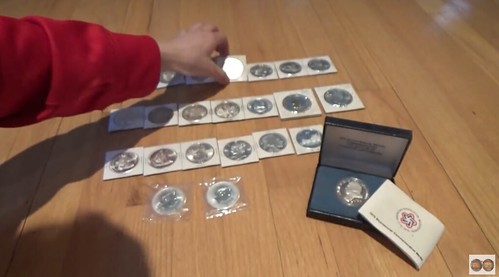
Len Augsburger writes:
Each year the ANA Summer Seminar features a pair of auctions to benefit the YN scholarship fund. These are held at the end of each week of the two-week event, with the catalogs prepared by the YNs themselves during the week. These auctions rely on donated material from the numismatic community (typical value $25 and up), and, to that end, YN Kenny Sammut has produced a video with an overview of the auction sale.
If you’ve got a few odd things in your collection (and who doesn’t?) this is great opportunity to clean out the bank box and refine your collecting objectives. It’s for a great cause, and your life will be slightly more organized as a result! The ANA will provide acknowledgment of all gifts. Contact Kenny Sammut via email, at numismatistkenny@gmail.com, for further info.
Links to the Kenny Sammut YN Auction video on YouTube and the Newman Numismatic Portal:
https://www.youtube.com/watch?v=U5_K-PmAlhI
https://nnp.wustl.edu/library/book/542803
About that "Red Book"
Paul Bosco writes:
Fastest sale I ever made was to a dealer in US Coins, at a Long Beach show. It was a book, a modern Scottish play called "The Slab Boys." Evidently, the boys mixed paints on marble slabs at a carpet factory. As I recall, I bought it from a street seller, coming out of the subway at First Ave and First Street, for $1 to $3, and I sold it for $10-15. This is a typical margin, for me at least, on book sales. In addition, books entail little quarreling over price and condition.
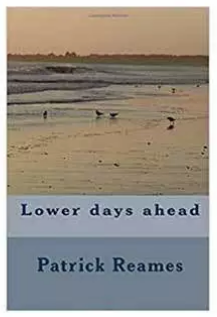 Lower Days Ahead is an Amazon print on demand paperback book filled with nonsense sentences, the kind found in spam email to make its way past Bayesian filters. The author is
"Patrick Reames" but when Reames received a 1099 form from Amazon he made $24,000 selling the book he was surprised, because he didn't write it or get any money from the sale of the
book. It's likely that criminals are using Amazon's print on demand program to launder money.
Lower Days Ahead is an Amazon print on demand paperback book filled with nonsense sentences, the kind found in spam email to make its way past Bayesian filters. The author is
"Patrick Reames" but when Reames received a 1099 form from Amazon he made $24,000 selling the book he was surprised, because he didn't write it or get any money from the sale of the
book. It's likely that criminals are using Amazon's print on demand program to launder money.
From Krebs on Security:
Reames said he suspects someone has been buying the book using stolen credit and/or debit cards, and pocketing the 60 percent that Amazon gives to authors. At $555 a pop, it would only take approximately 70 sales over three months to rack up the earnings that Amazon said he made.
To read the earlier E-Sylum article, see:
NOTES FROM E-SYLUM READERS: FEBRUARY 25, 2018 : A Rare Red Book (http://www.coinbooks.org/v21/esylum_v21n08a12.html)

VIEWING COINS OBLIQUELY
In the previous issue of The E-Sylum Dick Johnson made an off-hand comment about the correct orientation of a coin or medal. “The Mussolini token illustration in last week’s E-Sylum, which Editor Wayne stated was intact and could not be oriented correctly, brought to mind the task of orientation. The human mind craves correct visual perspective, everything on the level.”
Allow me to point out that in fact, “correct” orientation is learned from your cultural context and is not inherent to the human mind. Numismatics offers many counter-examples.
About 15 years ago, Geraldine Chimirri-Russell discovered that some issues of Celtic coins, which to us seem “Picasso-like” orient to correct 3-dimensional presentations of the human face when viewed at an angle. I attended a conference where she made this announcement ahead of her publications. Since then, her work has been reproduced and been cited by others. See for example, Money for Trade: A New View of Icenian Coinage by John Talbot (Oxford: Oxbow Books, 2017).
Preparing an article for the now-defunct Celator about the great fairs of Champagne in the Middle Ages (whence the “troy” actually Troyez ounce of precious metal), I found coins struck over a thousand years later that still exhibited that orientation. According to Chimirri-Russell, we only learned to accept the front-on view with vanishing-point perspective as a result of Renaissance painting.
Chimirri-Russell wrote:
“The highly stylized images on Celtic coins feature human profiles with dissociated features. The coins have been viewed as two-dimensional works, however, if the coins are perceived as three-dimensional objects that can be freely rotated in space, their properties can be interpreted equally freely. When viewed from an oblique angle, the dissociated facial features can be seen to realign producing a three-dimensional, realistic face seen from a three-quarter, rather than profile view. This optical illusion is found on the majority of examples of extant coins, thus indicating intent on the part of the Celtic artists. Other works in metal produced by the Celts indicate that the rotation of the object to reveal or transform images of hidden faces and animals was expected.”
See: “Taking an Oblique Point of View: The Challenges of Interpretation and Display in Museums,” The International Journal of the Humanities, Volume 5, Issue 12, pp.115-126, available at http://geraldineechimirri-russell.cgpublisher.com/product/pub.26/prod.1281 .
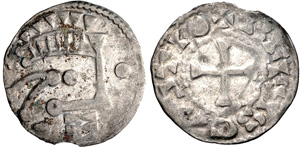
Classical Numismatic Group > Electronic Auction 413
Auction date: 31 January 2018
Lot number: 637
FRANCE, Provincial. Blois (Comté). temp. Thibaut III. Circa 1037-1089/90. AR Denier (20mm, 1.10 g, 5h). Stylized Blois-style head right; pellet to right / + BEISIS C?STIO, cross pattée. Duplessy, Féodales 578; Legros 968; Poey d'Avant 1690; Roberts 5056. VF, lightly toned.

Mike adds:
Note that the above illustration from p92 in the Iceni book is from a Sassanian coin. This was not limited to the Celts. It shows how peculiar our orthogonal views may be.
Here is a BNS newsletter that cites her presentation in 2004:
THE BRITISH NUMISMATIC SOCIETY Newsletter July 2004 (https://www.britnumsoc.org/publications/Newsletter_July_04.pdf)
To read the earlier E-Sylum article, see:
TIPS ON COIN DESIGN ORIENTATION (http://www.coinbooks.org/v21/esylum_v21n08a14.html)
DESIGN OF THE 2018 WINTER OLYMPIC MEDALS
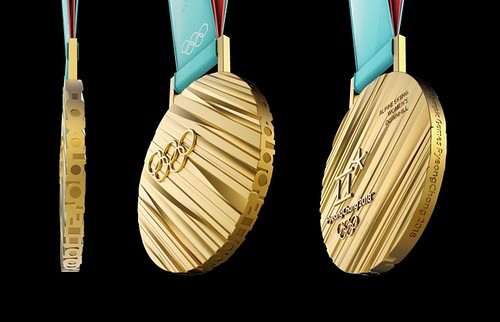
Every two years, the International Olympic Committee either holds a competition or chooses an individual or team from the host country to come up with a unique design for that specific Olympics. The design of the Summer Olympics medals is fairly strict — they must always include an image of Nike, the goddess of Victory — but the Winter Olympic medals start from a blank slate, although the designer is usually expected to incorporate the spirit of both the Olympics and the host culture into the medals themselves. This has resulted in a wide variety of designs, forms, and materials.
For this year’s events at Pyeongchang, the Olympics authorities approached Sukwoo Lee, an industrial designer based in Seoul. Lee’s company, SWNA, designs everything from robots to umbrellas and lamps. In an email to Hyperallergic, Lee said he presented five different concepts in the lead-up to the Olympics, all of them inspired by the landscape and culture of Korea. He said the four rejected proposals were “designed using the mountains of Pyeongchang as a motif, or using wind, trees, and Korean traditional ornaments as materials. The inside of the present [design] is the most modern, but it seems that the DNA of Korea is well expressed.”
The medals hanging around winning athlete’s necks this year take their inspiration from the Korean alphabet, as well as from traditional clothing and architecture. In a poetic illustration Lee provided Hyperallergic, the designer presents the alphabet, Hangul, as “the seed of our culture. We sow the seeds of culture. The seeds grow into a culture.” Once the seeds are fully grown and the flowers and fruit picked through, what’s left are the stems — “the stems are the process.” These individual “stems” of culture are then bunched together and cut into the circular shape of the medal, creating a bumpy surface but cut so you can still read the individual letters on the side. As for the traditional Korean clothing and architectural motifs, those come into play in the ribbons, made out of the same fabric as hanbok, and the upturned eaves of the wooden medal cases.
“I like experimental medals,” Lee said, adding that his favorite design from past Olympics is Dario Quatrini’s Torino 2006 medals with the hole in the middle. (He also liked the polycarbonate of the 2014 Sochi medals.)
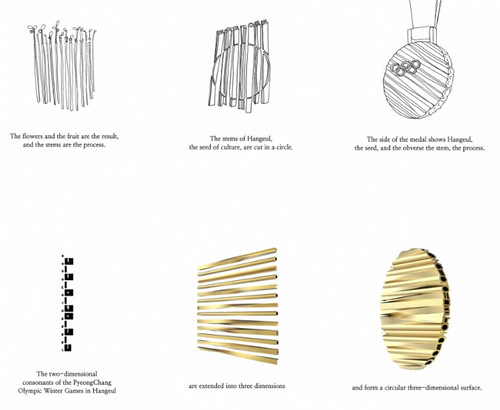
To read the complete article, see:
The Story Behind This Year’s Winter Olympics Medal Design
(https://hyperallergic.com/428310/winter-olympics-medals-design-sukwoo-lee/)
To read the earlier E-Sylum articles, see:
THE 2018 WINTER OLYMPIC MEDALS (http://www.coinbooks.org/v21/esylum_v21n06a33.html)
DICK JOHNSON ON THE 2018 WINTER OLYMPIC MEDALS (http://www.coinbooks.org/v21/esylum_v21n07a10.html)
VALUING THE 2018 WINTER OLYMPIC MEDALS (http://www.coinbooks.org/v21/esylum_v21n07a11.html)
VOCABULARY TERMS RELATING TO DIE WEAR
Three terms this week which have the same theme – wear in a die. Die erosion is used by collectors more so than mint workers, but, of course, anyone can use any term any time when appropriate. The theme of wear is vitally important to collectors in determining Condition.
Die Erosion. Wearing of a die’s surface until flow marks are entirely eliminated from pieces struck from that die. The term is one of condition used by collectors
studying pieces struck from dies rather than by metalworkers using the dies. Flow marks form on the surface of coins struck from a fresh die. Tiny furrows form on the surface, generally from the edge
toward the center, caused by minute imperfections on the surface of the die. These furrows reflect light causing MINT LUSTER on freshly struck pieces (also CARTWHEEL reflections when the coin is
tilted). With continued striking these imperfections slowly disappear and the die’s surface becomes smooth and bright. Continued use of the die causes very minute rounding of edges of detail and
lettering. After long-term use a die may SINK ever so slightly, beginning in the center and cause a very slight dome on struck pieces. The final stage of a die is when stress has caused a DIEBREAK on
the surface, usually near the rim. When the piece inevitably breaks away the die is no longer useable.
CLASS 11.5
Worn Die. A die whose sharpness of detail has been dulled by much use. The wear of constant striking rounds off the sharp angles of detail and lettering; in the later
stages of DIE LIFE the wear is greatly exhibited and dies deteriorate rapidly, until a point is reached when such dies must be retired. Before this is reached, however, some RE-ENGRAVING may be done
to add additional striking ability to prolong die life. Generally worn dies have begun to sink (see SUNKEN DIE), contain one or more areas of stress and are susceptible of DIECRACKS ultimately
leading to DIECHIPS and BROKEN DIES. Also WEAK STRIKES occur during SETUP, before the pressure has been correctly established, this results in pieces which look like they were struck from very worn
dies (but obviously were not). See also DIE WEAR.
CLASS 04.4
Die Wear. The dulling of detail on a die from constant striking. Wear diminishes the sharpness of detail and is the greatest factor of DIE LIFE – the point at which a
die must be retired. Also wear is a factor – along with stress – of DIECRACKS occurring which further hasten the deterioration of a die. In the later stages of a die’s life it will deteriorate
rapidly. See also SUNKEN DIE, BROKEN DIE.
CLASS 04.4
Looking for the meaning of a numismatic word, or the description of a term? Try the Newman Numismatic Portal's Numismatic Dictionary at: https://nnp.wustl.edu/library/dictionary
GEORGE EAVENSON (1854-1912)
George Eavenson (1854-1912), was born the fifth of five children on December 26, 1854 in Franklin Township, Chester County, Pennsylvania, son of Joseph Eavenson (1821-1892), and Sarah Ann Hannum Eavenson (1819-1911).
He worked as the Superintendent of Machinery for the Denver & Rio Grande Railroad at Denver, Colorado.
He applied in September and joined the ANA in October 1894.
Beginning in September 1894 he became a regular client of the Chapman Brothers.
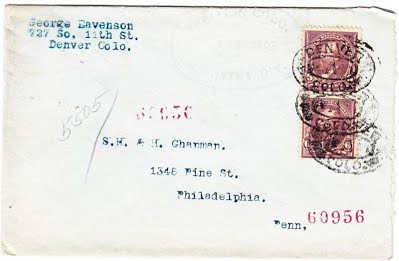
In 1902 he advertised in February issue of The Numismatist, he was looking to buy Clark, Gruber & Co., gold pieces as well as Mormon pieces.
His coin collection was sold by the Chapman Brothers on Thursday and Friday, April 26-27, 1903. The sale contained an 1856 over 1854 proof no arrows half dime in lot 102 and six proof 1841 Large Cents which came from a prominent Philadelphia collection, that Walter Breen deduced was that of Patterson Dubois (1847-1917). See Walter Breen's Complete Encyclopedia of U. S. and Colonial Coins, page 431. The notion, according to Breen, was that some coins in the Eavenson sale were those of the Dubois' collection that were mixed among them.
Eavenson does not seem to have continued as a coin collector after the sale.
He died on December 4, 1912, just 22 days short of his fifty-eighth birthday. He is buried in Cedaredge Cemetery, Cedaredge, Delta County, Colorado.
To read the complete article, see:
EAVENSON, GEORGE
(https://sites.google.com/a/numismaticmall.com/www/numismaticmall-com/eavenson-george)
The entire inventory of the Lupia Numismatic Library is for sale. Individual items will be available before the remaining archives are broken up into parcels sold at philatelic auctions in the U. S. and Hong Kong. Check NumismaticMall.com frequently as dozens of new items with estimates will be posted daily until everything is sold.
All inquiries will be given prompt and courteous attention. Write to: john@numismaticmall.com .

PROFILE: BANKNOTE COLLECTOR HAKKEEM MALIEKKAL
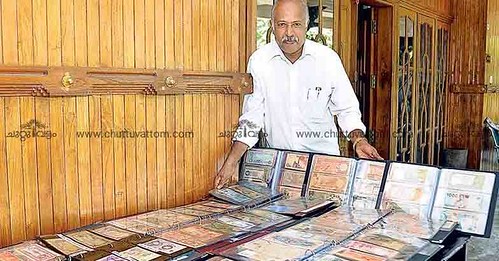
Hakkeem Maliekkal has stashed away bundles of currency notes and coins yet he enjoys a good night’s sleep. His treasure chest is an investment in historical research.
The retired teacher at Kayamkulam has enviable collection of currency notes from around the world. Among them are rare items such as a German silk currency, a mammoth Russian ruble and currencies printed on materials as varied as bark and golf foil.
Hakkim lives in nostalgia. Even house bears the stamp of a bygone era. He has turned his house into a museum for the benefit of history buffs. On display are currency notes from more than 380 countries and coins that have survived millennia. Entry to the private collection is free.
Hakkim’s collection includes currencies from 191 existing countries and 165 defunct countries apart from 25 islands. The collection earned him a place in the Limca Book of Records in 2017.
Old habits
Hakkim started collecting stamps and postcards as a boy. When he went to Saudi Arabia as a teacher, he hunted for collectibles. He would collect different currency notes from the money exchange centers. He widened his collection of coins by exchanging with other enthusiasts in numismatic societies.
He eventually obtained memberships in international societies. His association with the International Bank Note Society has helped him increase his collection manifold, he said. The society has members from about 100 countries exchanging the valuable items in their possession.
To read the complete article, see:
A bank note in silk? This former teacher can show you history in currency...
(http://english.manoramaonline.com/districts/alappuzha/2018/02/27/teacher-history-currency-alappuzha.html)
THE FREEDMAN'S BANK
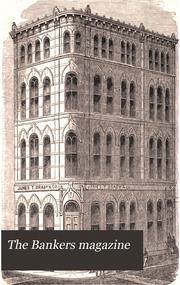 Because numismatic history is so often written by collectors, it tends to focus on objects: paper money, coins, tokens, and other relics of commerce that survive to be cherished and
studied.
Because numismatic history is so often written by collectors, it tends to focus on objects: paper money, coins, tokens, and other relics of commerce that survive to be cherished and
studied.
While coins survive the centuries more or less unchanged, wealth is far less durable. Numismatists collect and study all the symbolic manifestations of wealth, but in doing so they perhaps miss the forest for the trees.
The unique resources of the Newman Numismatic Portal offer abundant opportunity to study those symbols of wealth, from banking history, to paper money, to stock or share certificates, to coins made of gold and silver. Like a gravitational pull that suggests an unseen planet, these numismatic specialties can help us document the ebbs and flows of American wealth.
Of course, it is easier to study the presence of something than its absence. There are no $0 banknotes or certificates issued for 0 shares of stock. Because of this, the various underclasses that have been present throughout American history — and there have been many — often seem invisible to numismatists who focus on coins and currency. Medals and tokens, and various instruments related to debt, shed precious light on those corners other specialties miss.
The NNP is rich in banking history resources, many of which are hidden in plain sight: government publications that are dry reading to even the most studious among us, long runs of periodicals like The Bankers’ Magazine, whose title leaves no mystery as to what can be found within it. Aside from particularly geeky paper money enthusiasts, numismatists generally have little reason to delve in.
That is, unless they’re looking for the story of the Freedman’s Bank, whose material artifacts are as scarce as the wealth of the populace the institution first set out to help.
The Freedman’s Bank was incorporated as The Freedman’s Savings and Trust Company by Act of Congress on March 3, 1865. President Lincoln signed it on the final day of his first term, along with a stack of other bills passed by the previous lame-duck session of Congress. The next day, March 4, with Grant and Lee leering at each other outside the Confederate capitol of Richmond, Lincoln reminded the crowd gathered for his second inauguration that slavery “was somehow the cause of the war.” The conciliatory tone of Lincoln’s speech masked his bitterness over the struggle and the horrible cost it had exacted.
Knowing that the days of the conflict were numbered, preparations had begun for the reconstruction that would follow. The Freedman’s Bank was the brainchild of private philanthropists from the Northern abolitionist community who sought to give those formerly enslaved, soldiers in particular, a safe place to deposit their wages and develop savings habits. The idea was hatched that U.S. Government backing, even a bank charter, would help the institution serve its functions better than a solely private bank ever could. Charles Sumner, the abolitionist leader from Massachusetts, introduced the bill on March 2, 1865. It passed as an afterthought, and Lincoln signed it into law the next day.
By August 1869, the bank held more than a million dollars in deposits, representing the entire net worth of tens of thousands of men and women who had been enslaved just a half-decade earlier. Slowly but surely, the wages they worked so hard to earn were gathering interest, and the bank served to protect depositors from swindlers while helping to teach the basics of household economy. The reach of the Freedman’s Bank was nearly nationwide, with 24 branches established from St. Louis to Beaufort, South Carolina, from Savannah to New York.
To read the complete article, see:
The Freedman's Bank (https://nnp.wustl.edu/blog-post/515967)
ANA MONEY MUSEUM AND LIBRARY VIRTUAL TOUR
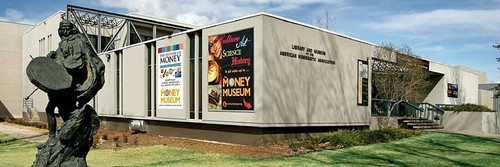
For the first time you can visit the ANA from home! Click the button below to take a virtual tour of the ANA’s Dwight Manley Library and Edward C. Rochette Money Museum. Explore the exhibits as if you were here and view close-up images of many of the objects, allowing you to view both sides of the pieces and see detail that is not visible in person.


To take the virtual tour (takes a while to load), see:
ANA MONEY MUSEUM AND LIBRARY VIRTUAL TOUR (https://www.money.org/money-museum-virtualtour)
ANS COINS FEATURED IN MUSEUM EXHIBITS
Dangerous Beauty: Medusa in Classical Art
Beginning in the fifth century BC, Medusa became increasingly anthropomorphic and feminine, undergoing a visual transformation from grotesque to beautiful. "Dangerous Beauty: Medusa in Classical Art," featuring a number of ANS coins, explores how the beautification of terrifying figures like Medusa, sirens, and other female half-human beings manifested in the idealizing humanism of Classical Greek art, and their enduring appeal in both Roman and later Western art.
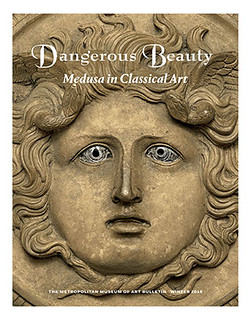 Beginning in the fifth century B.C., Medusa—the snaky-haired Gorgon whose gaze turned men to stone—became increasingly anthropomorphic and feminine, undergoing a visual transformation from
grotesque to beautiful. A similar shift in representations of other mythical female half-human beings—such as sphinxes, sirens, and the sea monster Scylla—took place at the same time. Featuring 60
artworks, primarily from The Met collection, this exhibition explores how the beautification of these terrifying figures manifested the idealizing humanism of Classical Greek art, and traces their
enduring appeal in both Roman and later Western art.
Beginning in the fifth century B.C., Medusa—the snaky-haired Gorgon whose gaze turned men to stone—became increasingly anthropomorphic and feminine, undergoing a visual transformation from
grotesque to beautiful. A similar shift in representations of other mythical female half-human beings—such as sphinxes, sirens, and the sea monster Scylla—took place at the same time. Featuring 60
artworks, primarily from The Met collection, this exhibition explores how the beautification of these terrifying figures manifested the idealizing humanism of Classical Greek art, and traces their
enduring appeal in both Roman and later Western art.
The connection between beauty and horror, embodied above all in the figure of Medusa, outlived antiquity, fascinating and inspiring artists through the centuries. Medusa became the archetypical femme fatale, a conflation of femininity, erotic desire, violence, and death. Along with the beautiful Scylla, she foreshadows the conceit of the seductive but threatening female that emerges in the late 19th century in reaction to women's empowerment.
For more information on the exhibit, see:
Dangerous Beauty: Medusa in Classical Art (https://www.metmuseum.org/exhibitions/listings/2018/dangerous-beauty)
The Horse in Ancient Greek Art
The Horse in Ancient Greek Art presents imagery of mythical horses like the winged Pegasos, who becomes a constellation, as well as horse-hybrids like centaurs and satyrs, creatures that are part human and part horse. Many artists depict chariots, sometimes rushing into battle and sometimes in thrilling races, while others focus on horse races, carefully indicating the goads, bridles, reins, and bits. These images as well as scenes of grooming and feeding well-bred steeds reveal striking parallels between ancient and modern horse care and horsemanship.
The Horse in Ancient Greek Art features Greek vases, sculpture, and coins from the 8th through the 4th centuries BC drawn from private collections, the Virginia Museum of Fine Arts, the Tampa Museum of Art, and other museum collections. The exhibition and accompanying publication explore the significance of the horse in ancient Greek culture, and imagery of the horse in ancient myth, war, sport, and competition. From some of the earliest examples of the horse in Greek art, to stunning examples of black and red-figure vases, the objects on view illustrate ancient equestrian life.
For more information on the exhibit, see:
The Horse in Ancient Greek Art (https://www.vmfa.museum/exhibitions/exhibitions/horse-ancient-greece/)
To read the earlier E-Sylum article, see:
NUMISMATIC NUGGETS: FEBRUARY 25, 2018 : Parion Hemidrachm with Gorgon Face (http://www.coinbooks.org/v21/esylum_v21n08a29.html)
For more information about the American Numismatic Society, see:
http://numismatics.org/

NATIONAL HELLENIC MUSEUM EXHIBIT
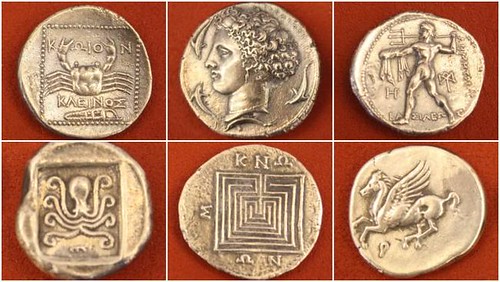
A new exhibition is set to open at the National Hellenic Museum this week in Chicago, featuring 29 coins that date back to the Hellenistic and early Roman periods (336BCE-55CE).
Entitled 'Change: The Story of Coins', visitors will have the chance to learn about Hellenism's influence on the use, production and design of coins, and as a result, their importance as a financial, cultural and political tool.
"Coins are some of our best records of political, social and economic change," said Katherine Kelaidis, Ph.D., Resident Scholar of the National Hellenic Museum.
"The coins in this exhibition demonstrate the vast reach of the Hellenic world in antiquity," she added.
"These coins represent a key moment in world history - the period in which Greek customs spread out of the Eastern Mediterranean and become the shared culture of educated people," Professor Kelaidis said.
The exhibition will open on Sunday 4 March, and will be on show until February 2019.
To read the complete article, see:
New exhibition features coins used in ancient Greece
(http://neoskosmos.com/news/en/New-exhibition-features-coins-used-in-ancient-Greece-National-Hellenic-Museum-Chicago)
LONG BEACH “SHIP OF GOLD” EXHIBIT
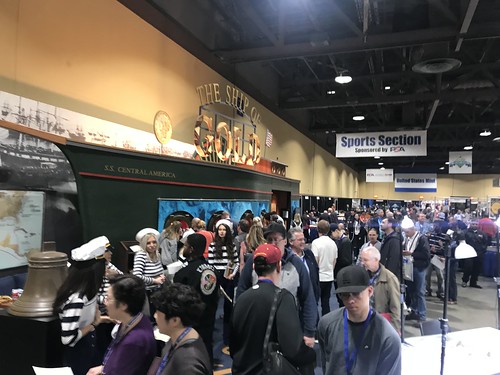
The “Ship of Gold” exhibit, with $40 million of never-before-displayed California Gold Rush sunken treasure recovered in 2014, attracted record-setting attendance during the February 22-24, 2018 Long Beach Coin, Currency, Stamp & Sports Collectible Expo.
The exhibit of gold and silver coins, nuggets and California gold dust was housed in a 40-foot long re-creation of the hull of the legendary SS Central America that sank in 1857, and sponsored by California Gold Marketing Group, owner of the trove.
“The three-day February 2018 Long Beach Expo set an overall attendance record for any Long Beach Expo since Collectors Universe, Inc. acquired the show a decade ago, and also set daily attendance records for Thursday, Friday and Saturday visitors. Overall, attendance at the February 2018 show was 43 percent higher than in February 2017,” said Cassi East, President of the Long Beach Expo (www.LongBeachExpo.com).
“Many members of the public told me they came to see a part of history, and many dealers told me that this was the coolest thing they’ve ever seen,” said East.
Los Angeles area television stations and TV networks covered the exhibit, and earlier there were stories by Associated Press and CBS This Morning about the treasure and the display. Crowds lined up to view the exhibit each morning when the Long Beach Expo doors opened to the public.
“We had visitors from across the United States and overseas. One collector told me he came from London, England just to see the exhibit,” said Dwight Manley, managing partner of the California Gold Marketing Group.
This was the first public display of a portion of the historic gold and silver coins, gold ingots and gold dust recovered during the 2014 expedition to the Atlantic Ocean site where the Gold Rush-era cargo was lost at sea 161 years ago. The California Gold Marketing Group LLC acquired the treasure from Ira Owen Kane, Receiver for Recovery Limited Partnership and Columbus Exploration, LLC in a court-approved transaction this past November.
“The exhibit included a new type of historic SS Central America item never before seen or displayed: leather satchels (pokes) filled with more than 1,000 ounces of gold bounty mined from the California Gold Rush!,” exclaimed Manley.
“The gold dust, mother lode quartz gold nuggets and other treasure have been in the original pokes since before Abraham Lincoln was president,” he said.
The ship sank 160 miles east of Cape Hatteras, North Carolina during a hurricane on September 12, 1857 while carrying tons of gold. There were 578 passengers and crew onboard, and 425 of them perished in the tragedy.
Bob Evans, the chief scientist and historian who has been on all three SS Central America recovery missions dating back to 1988, met with visitors during each day of the show and conducted two standing-room-only seminars about the treasure and its retrieval.
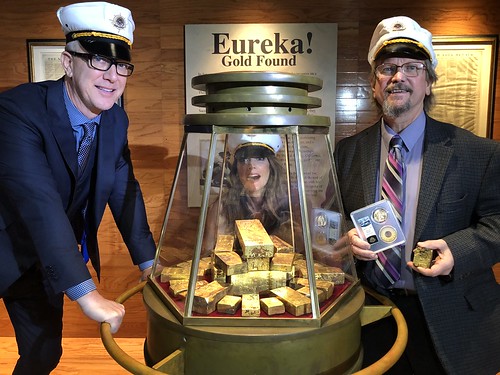
Dwight Manley, Christina Pascucci and Bob Evans at "Goldhenge"
He created a prominent display at the Ship of Gold exhibit by stacking 35 of the 45 recently recovered assayers’ ingots, ranging in size from 7.54 to 319.22 Troy ounces. He dubbed the display “Goldhenge.”
Evans now is curating and cataloging more than 15,000 U.S. and world gold, silver, and copper coins. A portion of the hoard is currently being certified by Professional Coin Grading Service (www.PCGS.com). The first of the treasure items are expected to be made available in the marketplace by selected dealers in April.
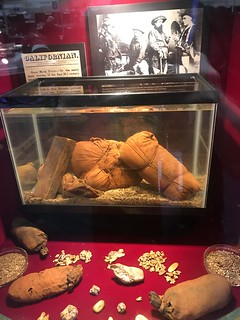
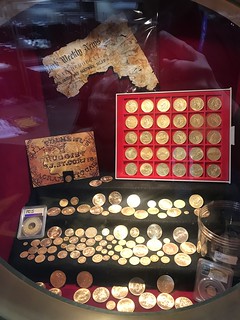
Highlights of the February 2018 Ship of Gold exhibit included miners' pokes unopened since 1857 displayed on a bed of gold dust along with an assayer's ingot and assorted gold nuggets [and a] sample of the gold coins recovered from the SS Central America in 2014...

Ship of Gold Exhibit staff
To read the complete article, see:
CoinWeek: Gold Shipwreck Treasure Worth Millions of Dollars on Display - 4K Video (https://www.youtube.com/watch?v=cbOWV27M_6U)
NUMISMATIC NUGGETS: MARCH 4, 2018
1859 Robert Lovett Die Sinker Token
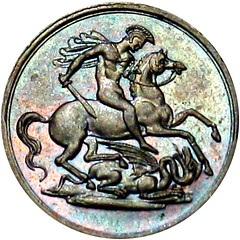
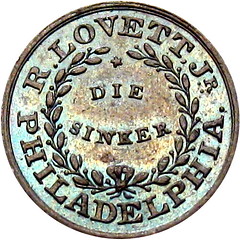
Pre Civil War 1859 Merchant token Miller / Rulau PA 351A Nice Uncirculated. Image of St. George slaying a dragon on obverse. R. Lovett, Jr. Die Sinker Philadelphia.
To read the complete lot description, see:
(https://www.ebay.com/itm/1859-Philadelphia-Merchant-Token-Robert-Lovett-Die-Sinker-St-George-Dragon-/202238387963)
Bermuda Hog Penny Pub Good-For Token
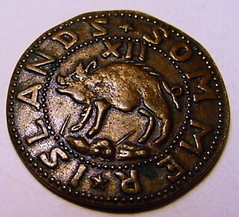
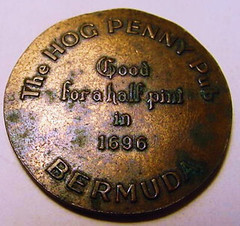
Description: BERMUDA HOG MONEY ADVERTISING MEDAL
The Hog Penny was formerly a bicycle shop selling Penny Farthing bicycles before being converted to a meat slaughterhouse selling huge blocks of ice that had been shipped in from North America during the winter. When it first opened as the Hog Penny, during the late stages of segregation, shockingly, it had a divider down the middle of it to separate the races. Soon though, equality prevailed and the middle divider was removed. The Hog Penny was cobbled together from old Watney's pubs in England that were being withdrawn and many of the mirrors, benches and sheep shearing tools you see on the shelves date back to the early 1900s.
Hog Penny is Hamilton's oldest licensed establishment having been in business since 1957. It's the original inspiration for the Cheers pub in Boston.
To read the complete lot description, see:
Lot 219: BERMUDA HOG MONEY ADVERTISING MEDAL (https://www.invaluable.com/auction-lot/-1-c-07F4EDFB97)
To visit the Hog Penny web site, see:
http://www.hogpennypub.com/
Federal Tires Medal
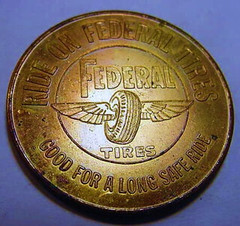
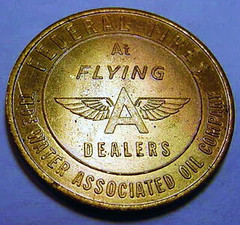
To read the complete lot description, see:
Lot 284: FLYING A FEDERAL TIRES MEDAL (https://www.invaluable.com/auction-lot/-1-c-E5046A1AA5)
For the Federal Tires web site, see:
http://www.federaltire.com/en/
For a short history of Tidewater Oil, see:
https://www.linkedin.com/pulse/history-tidewater-oil-company-zulker-naeen/

MEDAL SELECTIONS FROM NUMISMAGRAM: POWER STRUGGLES
If you visit the web site, be sure to roll your mouse over the medal images for highly detailed close-up views. -Editor
Napoleon I Westphalia Medal

100241 | FRANCE. Napoleon I bronze Medal. Dated 1807. Creation of the Kingdom of Westphalia (40mm, 38.75 g, 12). By Brenet & Denon. NAPOLEON EMP ET ROI, laureate head right / INJECIT TANDEM FRENA VACANTI, Napoleon standing facing, head right, holding bridled horse rearing rightward from behind him; in two lines in exergue, ERECTION DU ROYAME / DE WESTPHALIE. Edge: Plain. Bramsen 660; Julius 1788; d'Essling 1183. Choice Mint State. Sublime red-brown surfaces, with exceptionally refined artistry and detail.
A fairly short-lived kingdom created by Napoleon and for his brother Jérôme to rule, Westphalia occupied a part of what is now modern-day northern Germany. It was intended to be a model state of egalitarian law not common for its time. Financial issues quickly beset this vassal kingdom, however, and, following Napoleon’s retreat from his failed march on Russia, the kingdom was mostly absorbed into the Prussian kingdom. This medal commemorates Napoleon’s “carving up” of parts of Europe, highly idealized and not in any way indicative of the problems which would beset both him and his fraternal slice of the map only a few years later.
To read the complete item description, see:
100241 | FRANCE. Napoleon I bronze Medal.
(https://www.numismagram.com/product-page/100241-france-napoleon-i-bronze-medal)
Germany-Jiaozhou Satirical Medal

100219 | GERMANY, GREAT BRITAIN, CHINA & JAPAN. Satirical bronze Medal. Dated 1914. World War I series: The Defense of Jiaozhou (Kiauchau/Kiautschou) (33mm, 15.41 g, 12h). Unsigned. Crowned eagle (representing Germany) perched in oak tree; to lower left, British officer sending monkey (dressed in Japanese unifrom) up the tree in which three other bodies hang lifeless / DER / ENGLÄNDER / UND SEIN JAPANER / "JETZT KLETTRE DU MAL / AUF DIE DEUTSCHE EICHE / UND VERSUCHE, / OB DU IHM NICHT EINE / FEDER AUS DEM SCHWANZ / REISSEN KANNST!" (The Englishman to his Japanese pet: "climb up this oak and see if you can pluck a feather from the eagle's tail!") in nine lines. Edge: Plain. Cf. Zetzmann 4062 (silver). Choice About Uncirculated. Warm reddish-brown surfaces and a light, charming tone. Rare.
Jiaozhou, an important and strategic naval location, became the focus of German interests at the end of the 19th century, and a 99-year lease was signed with the Qing Dynasty for its use by the German Empire. This lease continued after the fall of the former and during the period of its successor, the Republic of China, until the outbreak of World War I, at which point, the Japanese Empire delivered an ultimatum to Germany, demanding that it relinquish control of the region.
This ultimatum was rejected, whereupon Japan began a bombardment of the territory, ultimately resulting in their seizure of Jiaozhou. It was eventually returned to Chinese control in 1922, but was again occupied by the Japanese during World War II. So many conflicts over such a (relatively) small piece of real estate!
To read the complete item description, see:
100219 | GERMANY, GREAT BRITAIN, CHINA & JAPAN. Satirical bronze Medal
(https://www.numismagram.com/product-page/100219-germany-great-britain-china-japan-satirical-bronze-medal)
TEXAS JOLAS OFFERED IN KAGIN'S MARCH 2018 SALE
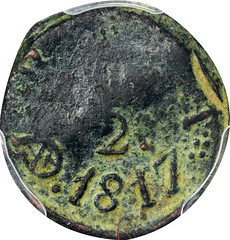

1817 Jola
Kagin’s auction to feature 1817 and 1818 New Spain (Texas) jolas – the first ever date set offered at their ANA National National Money Show auction at the Irving, TX Convention Center.
The ANA National Money Show in Irving, Texas, March 8-10 will have a double dose of Texas rarity up for sale in Kagin’s auction. Lots 1027 and 1028 will feature two jolas, small copper coins struck for regional use in Spanish Texas. They are dated 1817 and 1818 respectively.
In the interior of Texas there was a bustle of commerce and daily activity around the early Spanish missions of the early 1800s. The areas of San Antonio, Goliad, and Nacogdoches had flourished and became the most successful of the Spanish settlements. Only four years after the brutal suppression of an armed uprising in 1813, an uneasy peace had been established. The Presidio of San Antonio de Béxar was once again thriving, but still boasted a large number of Spanish troops among its population. It was in this relatively quiet period during the struggle for Mexican Independence from Spain that an obscure but significant event in the history of Spanish Texas occurred. An impromptu minting of small copper coins in San Antonio de Béxar would mark the first appearance of the five-pointed lone star—the symbol for Texas.
Once the coins were minted, a public notice was posted, “Our neighbor Don Manuel Barrera having petitioned to this government the milling of five hundred pesos in total containing his name and surname; this government has accepted this individual’s solicitation to mill five hundred pesos in total, with a value of half a real for each for use in purchases and sales and should circulate in the commerce of this city and no one should decline to accept them. I sign this in San Fernando de Bexar on the 29th day of the month of March in 1817 to advise the public.”
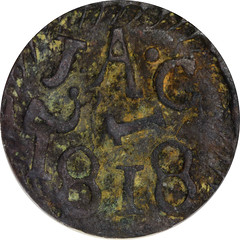
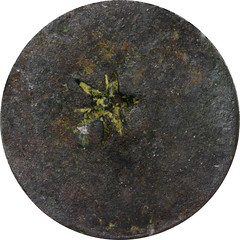
1818 Jola
The 1818 New Spain (Texas) jolas have been well known in the numismatic world since the discovery of some 60 or so jolas along the bank of the San Antonio River in 1959. Although the 1817 decree gave the authorization to mint the jolas, the 1817 coins were an elusive rarity that had only existed by paper decree, but which finally came to light for the first time in my 2009 book, The Paper Republic: The Struggle for Money, Credit, and Independence in the Republic of Texas. There were, in fact, 1817 dated jolas which bore the initials “MB” on the obverse, the denomination ½ (real), with a horizontal fraction, the numerator “1” on the right side, and an incuse five- pointed lone star on the reverse. One of the five discovery pieces is now the plate specimen on page 79 in the “The Official Red Book”, or the Guide Book of United States Coins 2015 by R. S. Yeoman, edited by Kenneth Bressett.
But numismatics can be a dynamic and ever changing field as new information and new discoveries come to light. In 2010, I became acquainted with a Dallas collector, who showed me three small copper coins, dated 1817, that he and a friend found while metal detecting in the mid-1960s. They were dug up at the site of Mission San Bernardo, adjacent to San Juan Bautista at the present day town of Guerrero, Mexico near Eagle Pass. Spanish explorers used these early missions as a staging area for expeditions into Texas. This places these coins squarely in the trade route from San Antonio de Bexar to the interior of Mexico. One of these coins had a three-digit date “817”, the other two had a four-digit date “1817.” One of those later specimens is the same as is being offered in the Kagin’s auction.
This 1817 (New Spain) Texas jola is offered as lot # 1027 in the Kagin’s sale. It is certified and graded as F-12 by PCGS. The catalogue states that it “was the first 1817 jola to be certified by any major grading service.” This specimen is earthy in appearance with the patina-like surfaces often found on ancient bronze coins. Areas of deep rusty brown and pale sea-green patination share the obverse. The ½ denomination is vertical, with the denominator, “2”, boldly evident, as is AD 1817, those areas the boldest of all the design elements. The letter “R” appears in the obverse legend but the remainder of the letters are obscured by heavy wear and/or a weak strike, save for an “I”. The reverse bears a multi-pointed motif on the reverse which resembles a flower rather than the distinct, incuse five pointed lone star found on the reverse of the 1818 specimen. Undoubtedly this ½ real piece is also an 1817 jola, as it was a small copper coin used to make change. All known specimens were struck from crudely cast dies.
The low survival rate of the 1817 jolas can be explained in part by their withdrawal from circulation on the order of local authorities on December 6, 1818. A posted order recalling the Barrera coins translates in part:
“The circulation of the previously minted coins by D[on] Manuel Barrera should cease today. And with the effect that whoever has the jolas minted by Barrera should not lose them and present them to D. Jose Antonio Lagarza [sic] within 12 days. He will receive them and give them the same quantity of the newly minted coins.
The 1818 (New Spain) Texas jola is offered as lot # 1028 in the Kagin’s sale. It is certified and graded as VF-35 by PCGS. This small planchet variety has deep olive-brown surfaces that are somewhat crusty in appearance, a good sign that this specimen has never been tampered with, never harshly cleaned, and has a pleasingly original appearance. Obverse with J.A.G. at the top, 1818 at the bottom, ½ on its side in the center, with the numerator “1” on the right side, large spiked dentils nearly encircle the periphery. The otherwise unadorned reverse is impressed with a hand-entered five-pointed lone star at center. It represents the symbol for Texas, the Spanish territory in which it was struck for regional use. This specimen presents a rare opportunity to acquire an 1818 jola with the lone star reverse in an altogether excellent state of preservation.
The Kagin’s sale is also highly unusual in that there are offered both an 1817 and 1818 dated New Spain (Texas) jolas for sale. It’s not a frequent occurrence to find a single jola in a public auction sale, and now resourceful bidders have the opportunity to take home two prizes, perhaps even as a pair to one tenacious bidder if he or she plans their strategy accordingly. A mere nine years after the opening salvos of disclosure for these rare Texas half-real pieces, came to light, the fame of this rarity has spread near and far. The two coins being offered present a collecting opportunity as big as Texas.
James P. Bevill is the author of The Paper Republic, The Struggle for Money, Credit and Independence in the Republic of Texas.
Author’s note: (Bevilll’s first edition contained a translation error of the mintage as 1,500 pesos. Although this error was corrected to 500 pesos in the 2011 Numismatist article Lone Stars Rising, and in the second edition of The Paper Republic,2012, the mistake was quoted and in the 2012 Stacks Bowers auction catalogue, where the present 1817 jola being offered was listed as Lot# 11155.
SELECTIONS FROM HOLABIRD MARCH 2018 SALE
Hart's "Coins of the West" Set
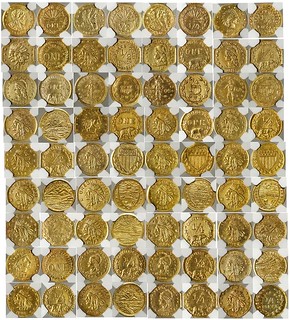
Thirty six coin set in Mint State Condition ranging from MS 63 to MS 66. Four MS 66; fifteen MS 65; fifteen MS 64; two MS 63.
Similar in shape and dimension to the California Fractional Gold series, the privately struck gold “Coins of the Golden West” have been puzzling researchers for decades. Struck in 10 ct. gold or finer (with the Alaska-Yukon series coming in at approx. 21 ct, according to Burnie), these mysterious and gold issues are a colorful commemoration of all U.S. gold rush locales and feature unusual denominations such as Pinch, DWT and Minerva Bear.
The group includes: Alaska Pinch Series – 6 pcs., Parka Heads – 3 pcs., Alaska-Yukon Expo – 3 pcs., Minerva Bears – 6 pcs., Indian Bears – 6 pcs., Idaho Gold – 3 pcs., Montana Gold – 3 pcs., Oregon Gold – 3 pcs., Washington Gold – 3 pcs.
M.E. Hart, the original marketer of these beautiful gold tokens (along with Farran Zerbe) is even somewhat of a mystery – speculation exists that it is the person of Mary E. Hart, one of the most prominent and flamboyant businesswomen of the era.
A brief look at the trajectory of her life puts Mary E. Hart at the epicenter of the Golden West set distribution:
By 1904, Mary Hart was traveling regularly between San Francisco and Alaska, as well as Los Angeles and Tacoma – a tireless promoter of Alaska, she was the manager of Alaska’s exhibits at the 1904 Louisiana Purchase Exposition in St. Louis, continuing her Alaska promotions into the 1909 Alaska-Yukon-Pacific Exposition. She also had family connections with Mayer and Brothers Jewelers, makers of the Alaska-Yukon tokens, and was active in marketing all the Golden West issues at the 1916 Panama-Pacific International Exposition. While there is no “smoking gun” indicating that Mary E. Hart was responsible for producing the “Coins of Golden West”, ancillary evidence strongly suggests that she was in the thick of it. With her interest in the gold industry (and an impressive collection of Alaska gold nuggets), she is a natural fit for the persona of “M.E. Hart”, the original promoter of these fascinating private gold issues.
To read the complete lot description, see:
Outstanding "Harts Coins of the West" Set
(https://holabirdamericana.liveauctiongroup.com/Outstanding-Harts-Coins-of-the-West-Set_i29369875)
Denver Mint and Colorado Bank Books
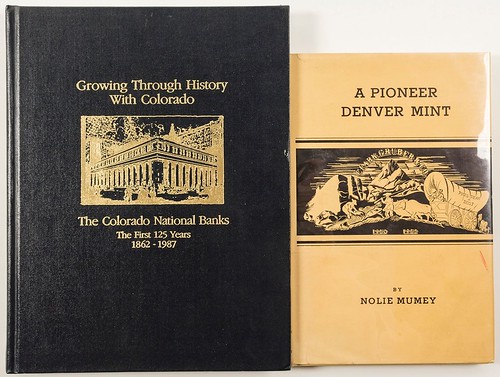
Hardcovers. A Pioneer Denver Mint by Mumey, Growing Through History with Colorado, The Colorado National Banks 1862-1987 by Noel (Al Adams Gold Rush Memorabilia Collection) Date: Location: Denver, Colorado
To read the complete lot description, see:
Denver Mint and Bank Books (2)
(https://holabirdamericana.liveauctiongroup.com/Denver-Mint-and-Bank-Books-2_i29369827)
Letter By Snowden to J. M. Patton
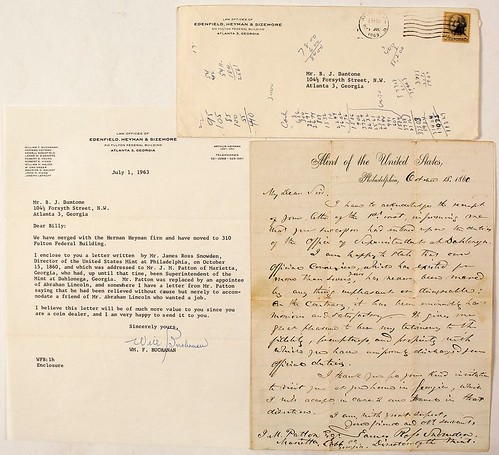
One page letter on Mint of the United States Stationary. Director of the Mint James Snowden acknowledges the admirable job that Patton had done the last seven years. (He had been replaced by a President Lincoln friend.) Also says will take him up on staying with Patton if he ever gets down that direction. Snowden goes on to heap praises on Patton for the job he did. Snowden signs the letter, "your friend and obedient servant". This is a must for any Dahlonega or Patton collector! Some rips at fold edges. Accompanied by a 1963 letter to Blaise F Dantone, the legendary owner of Peachtree Coin Shop about this 1860 letter.
Patton brought a new level of professionalism to the Dahlonega Branch Mint. Patton found that the gold coins issued at the Branch Mint were too high in silver, and had uneven planchet weights. He discovered that the rolls used to make the planchets from the Georgia gold were worn out, and the thickness, and therefore the weight, varied upt o 3/16 of an inch, as noted by Head and Etheridge in The Neighborhood Mint. (2000). The high silver also caused the coins to wear far too quickly, which is quite obvious to collectors today.
To read the complete lot description, see:
Letter to J. M. Patton from Director of the U. S. Mint in
Philadelphia (https://holabirdamericana.liveauctiongroup.com/Letter-to-J-M-Patton-from-Director-of-the-U-S-Mint-in-Philadelphia_i29369833)
Amador Canal & Mining Company $5 Gold Note
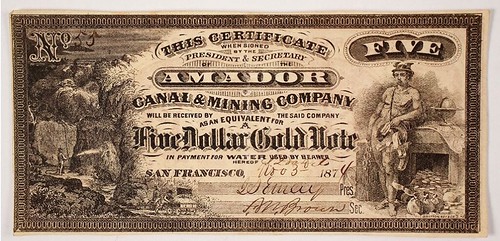
Dated Nov. 3, 1874, serial number 55. An extremely rare California scrip item which is as close to a true obsolete note as exists from California. This note is payable for water used by the bearer and is "an equivalent for a Five Dollar Gold Note," a clear reference to the then current National Gold Bank. Signed by the President, J. S. Emery, and Secretary, A. M. Brown.
A vignette at left shows a miner operating a water canon in a hydraulic mining scene with another two miners below working near a tunnel. On the right is a second vignette of Mercury standing with an open safe with piles and sacks of coins and ingots. The back is in ornate gold-orange I color and features a portrait of Neptune, appropriately god of the sea. Printed by Britton, Rey Co., S. F.
Extremely Rare; not in the John J. Ford collection. A few specimens of a $1 dollar note are known by the same company and one.is listed in the Holabird Kagin Gold Rush catalog Summer 2008 (item #72) at a price was $12,500. Only one unissued $5 note is known in much less condition than the item listed here. (From the Horwedel Collection, item # 15431 in the Heritage Auction No. 354 on Sept. 8th, 2004.)
To read the complete lot description, see:
Amador Canal & Mining Company $5 Gold Note
(https://holabirdamericana.liveauctiongroup.com/Amador-Canal-Mining-Company-5-Gold-Note_i29370033)
Carson City Mint Photo
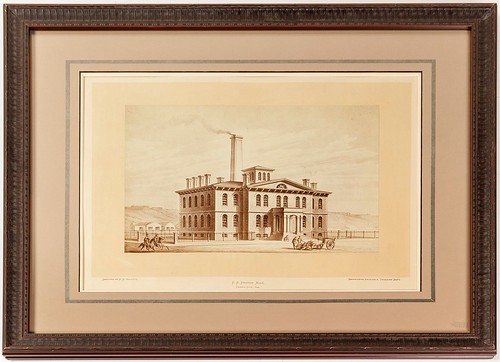
Original mammoth photo print of the US Mint in Carson City, NV. Drawing by A. B. Mullett. A duo of oxen attached to a cart are laying down in front of the mint while 2 men on horses are approaching from the left. A man is sitting on the mint steps. This is quite a contrast to this surviving building in Carson City today which is in the center of town and now part of the Nevada State Museum. 20th century frame. Frame 20" x 23", photo 8.5" x 12".
To read the complete lot description, see:
Original Carson City Mint Mammoth Photo Print, c.1868
(https://holabirdamericana.liveauctiongroup.com/Original-Carson-City-Mint-Mammoth-Photo-Print-c-1868_i29369846)
William Windom $2 Silver Certificate
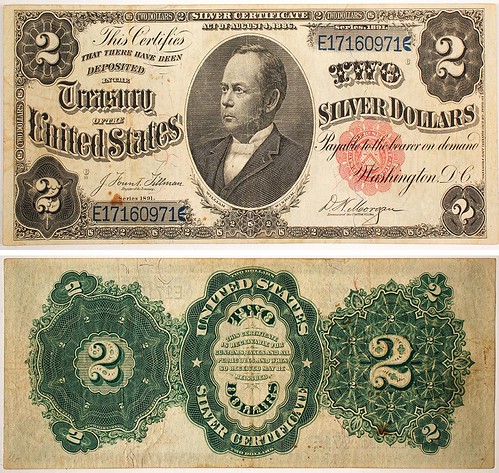
Friedberg #246. Bust of William Windom, Secretary of the Treasury March to November 1881 and 1889-1891. Signed Tillman/Morgan. Uncertified, VF-EF condition. This type lasted through only two signature combinations, and appearances of high-end examples are seldom seen for sale.
To read the complete lot description, see:
$2 Silver Certificate (https://holabirdamericana.liveauctiongroup.com/2-Silver-Certificate_i29370019)
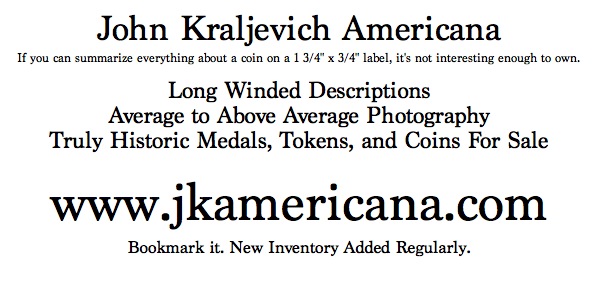
ARCHIVES INTERNATIONAL SALE #47 ANNOUNCED
U.S., CHINESE AND WORLDWIDE BANKNOTES, SCRIPOPHILY AND COINS WILL BE OFFERED IN 2 SESSIONS AT PUBLIC AUCTION ON TUESDAY, MARCH 13th , 2018
Archives International Auctions will hold the auction, at their offices in Fort Lee, N.J.
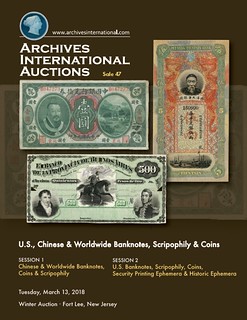 The March auction will feature an extensive collection of over 950 lots of U.S., Chinese and worldwide banknote rarities; worldwide scripophily, coins, and security printing ephemera. Also
included in the auction are U.S. and world coins from an old estate collection featuring a nice assortment of Italian States and World Coins that deserve further inspection and hundreds of additional
banknotes, stocks, bonds, and autographs.
The March auction will feature an extensive collection of over 950 lots of U.S., Chinese and worldwide banknote rarities; worldwide scripophily, coins, and security printing ephemera. Also
included in the auction are U.S. and world coins from an old estate collection featuring a nice assortment of Italian States and World Coins that deserve further inspection and hundreds of additional
banknotes, stocks, bonds, and autographs.
Numerous consignments from old estates and family collections are included with many items having been off the market for over 25 to 50 years. The sale is broken into two sessions, the first includes Chinese and Worldwide Banknotes, Chinese Scripophily, and World Coins, while the second session begins with U.S. coins, then Colonial and Obsolete banknotes, U.S. type notes, MPC, Depression Scrip and Security Printing Ephemera followed by U.S. and World Scripophily.
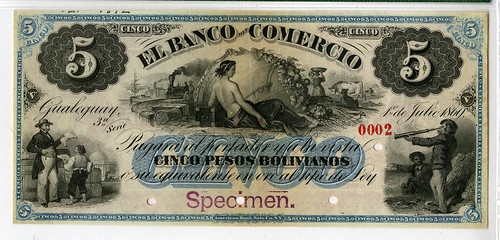
Lot 3 Argentina, Banco Del Comercio, 1869 Specimen Banknote
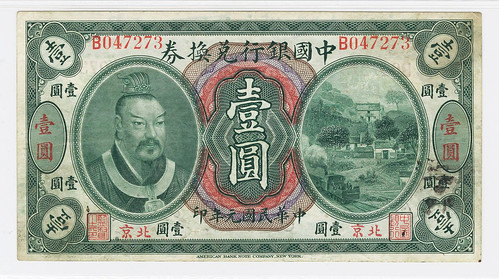
Lot 73 Bank of China, 1912 Peking Branch Issue Rarity
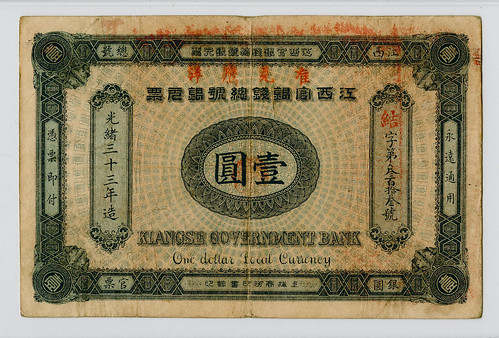
Lot 129 China, Kiangse Government Bank 1907 Dollar Issue
The first session begins with over 500 lots of world banknotes featuring 130 lots of Chinese banknotes and scripophily; over 30 lots of modern Iran specimen banknotes, all different, with a majority new to the collecting community; an impressive assortment of Colombia proof banknotes with many rare notes in high grades as well as hundreds of other attractive, rare, and desirable banknotes. A few additional highlights include Argentina, 500 Pesos, Banco De La Provincia De Buenos Aires, 1883 Unique Production Proof Model, est.$700-$1200; A 1968 Bahamas Monetary Authority set of 8 Specimen banknotes, 50cts to $100, est.$1750-$2000; a pair of extremely rare Chile, ND (ca.1870) El Banco Agricola Specimen Banknotes, 1 and 5 Pesos, both unlisted as specimens and unpriced in the SCWPM with low estimates at $1200 and $1600 respectively; a 1912 Bank of China, Peking Branch rarity, $1, P- 25w, possibly the finest known, est.$4000 to $8000; 4 examples in high grade of 1907, Kiangse Government Bank, $1 banknotes from a new find, est.$1000-$2000 each; and an outstanding, ND (ca.1910) Peiyang Tientsin Bank 5 Taels rarity, est.$6000-$8000. Included are 22 lots of Chinese Railroad bonds, ca.1904-1911; a desirable 1905 National Bank of Danish West Indies Uniface $10 Proof, the finest of 4 graded in the PMG census, est.$1250-$1750; over 17 lots of French Revolution Era Siege Notes with many rare varieties; a Bangko Sentral ng Philippines, 1998 Commemorative 100,000 Piso Banknote, est. $9000-$10,000; and an extremely rare United Arab Emirates Currency Board, 1982-1989 Specimen Set of 6 notes in its original booklet overprinted Specimen in English and Arabic in Uncirculated to Gem Uncirculated condition, est.$7000-$10,000 in addition to hundreds of other desirable banknotes in every price range.
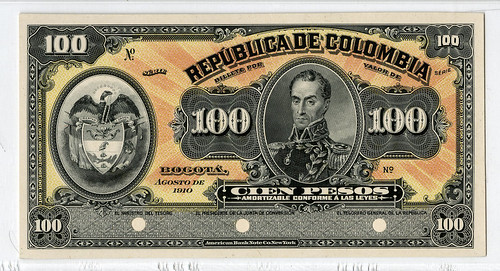
Lot 216 Republica de Colombia, 1910, 100 Pesos Proof

Lot 242 National Bank of Danish WI, 1905 10 Francs Proof Banknote
The second session includes 400 lots of U.S. coins, currency, scripophily, security printing ephemera and autographs. Highlights include a very attractive Bust Half Dollar collection of 10 different coins from an old estate, est.$1000-$1500; Colonial and Obsolete Currency highlighted by 2 examples of high grade “DIX” notes, est. $600-$900; numerous obsolete proofs from the “Silver City Collection” with many off of the market for over 7 years and extremely rare including an 1830’s, $100, Merchant Bank of Baltimore rarity, est. $600-$900; and an 1830’s, $20, Bank of Burlington Proof, est. $600-$1000. Over 20 lots of Security Printing Ephemera are offered highlighted by 3 lots of National Bank Note Company Proof Vignette sample pages, ca.1850-70’s with many rare and unique vignettes used on banknotes, fiscal documents, stocks and bonds. An extremely rare 1894, Type V, U.S. Postal Note from Elkton, Oregon is offered, est.$1250-$2000.
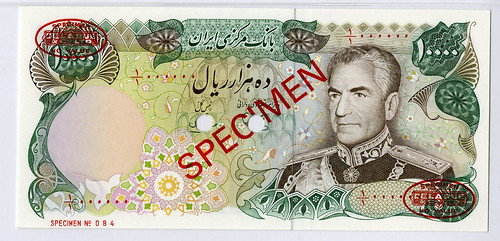
Lot 337 Bank Markazi Iran, ND (1974-1979), 10000 Rials, P-107s Specimen
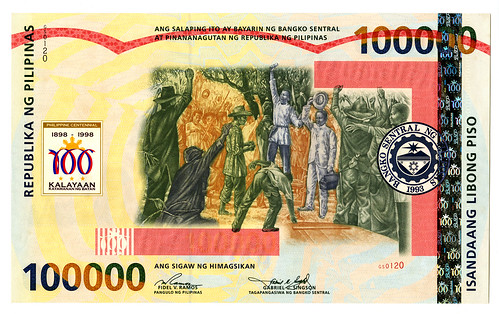
Lot 457 Bangko Sentral ng Philippines, 1998 Commem 100,000 Piso Banknote

Lot 768 Irish Republic 1866, $20 Issued Bond Rarity

Lot 793 Alaska Gold & Silver Mining Co 1878 Stock Certificate
The Scripophily section is represented by 250 lots covering numerous topics including Automobiles, Aviation, Mining, Banking, Technology, Railroads as well as foreign bonds and shares. Highlights include a 1904, Ford Motor Company of Canada Stock Certificate signed by Hohn S. Gray, president of both Ford U.S.A. and Ford Canada and issued on the first day of the company, December 17 th , 1904, est. $900-$1250; an early Bank of Baltimore, 1798 Stock Certificate, est.$750-$1250; an extremely rare Pain’s Fireworks Co., 1896 I/U stock certificate est. $600-$900 and first time seen by cataloger; an impressive 1866, $20, I/U, Irish Republic Bond; an extremely rare and historic 1878 Alaska mining certificate, Alaska Gold & Silver Mining Company, Baranoff Island, issued 11 years after the purchase of Alaska (Seward’s Folly) and possibly one of the earliest Alaska Stock Certificates know, est. $3000- $5000; an 1887, Meigs Elevated Railway Construction Co. bond signed by Civil War General Benjamin F. Butler as president, est. $800-$1600; as well as dozens of additional scripophily rarities.
The auction will feature hundreds of additional rare and desirable banknotes, coins, and scripophily in every price range, for the beginner to the advanced collector. Previews will be held at Archives International Auctions offices Wednesday, March 7 th to Friday, March 9 th, and Monday March 12 th between 10 AM and 5 PM and by appointment. For an appointment call 201-944- 4800 or email info@archivesinternational.com.
The online catalog for the March 13 th sale is on Archives International Auctions’ website and can be viewed via the Archives International Live bidding platform. It can also be viewed as a Virtual Catalog or downloadable .pdf on their website. To pre-register for live internet bidding, log on to the Archives International Auctions website, at www.ArchivesInternational.com.
We are now working on our Spring and Summer 2018 auctions and are seeking quality consignments. Please consider us for outright purchase including U.S. and worldwide banknotes, coins, stocks, bonds, stamps, postal history, historic ephemera, autographs. To sell or consign one piece or an entire collection, please call AIA at (201) 944-4800; or e-mail them at info@archivesinternational.com.
You may also write to Archives International Auctions, at 1580 Lemoine Ave., Suite #7, Fort Lee, NJ 07024 U.S.A. To learn more about Archives International Auctions and the auctions planned for March 13th , log on to www.ArchivesInternational.com.
RETAINING EQUITY IN NUMISMATICS
 What would happen if the artists Jasper Johns and Robert Rauschenberg had retained 10 percent equity in the artwork sold in the start-up phase of their careers? This question is the focus
of a new study from the NYU Steinhardt School of Culture, Education, and Human Development in partnership with the University of Luxembourg introducing a novel investment framework to reflect the
artist’s role as an early stage investor in their own work.
What would happen if the artists Jasper Johns and Robert Rauschenberg had retained 10 percent equity in the artwork sold in the start-up phase of their careers? This question is the focus
of a new study from the NYU Steinhardt School of Culture, Education, and Human Development in partnership with the University of Luxembourg introducing a novel investment framework to reflect the
artist’s role as an early stage investor in their own work.
For instance, a 10% equity stake in Rauschenberg’s work State—sold in 1959 for $300—would have become $44,000 in the art market. The same $30 investment in the S&P 500 would have returned $2,417 over the same time period.
Whitaker acknowledges the results are buoyed by the meteoric success of the artists in the study, but indicated the outsize returns show why shared value matters. “It’s necessary to have a conversation about artists being modeled as investors, whether they become as successful as Johns and Rauschenberg or not.
As a collector, retaining equity is one way past the dilemma of seller's remorse. You still own a piece of that favorite piece, and its value continues to rise or fall with the market. At some later date you could sell that share. A bookkeeping nightmare, but we have computers to handle that nowadays, just like the systems tracking royalty payments for music artists. Dealers today often pool their funds and share risk by buying major rarities together, each having their own equity share. This model would allow those equity stakes to live beyond the next sale to all future sales.
Financial engineering in numismatics and elsewhere can often end badly. The overhead and potential for swidling can more than eat up the desired benefits. But it's still a fun thought experiment for anyone who's watched something he once sold resell for multiples of the earlier price.
-Editor
To read the complete article, see:
New research models how artists can benefit from retaining equity in
work (http://artdaily.com/news/102888/New-research-models-how-artists-can-benefit-from-retaining-equity-in-work#.WpvomejwaAs)
15TH CENTURY COIN HOARD FOUND NEAR DUTCH CITY
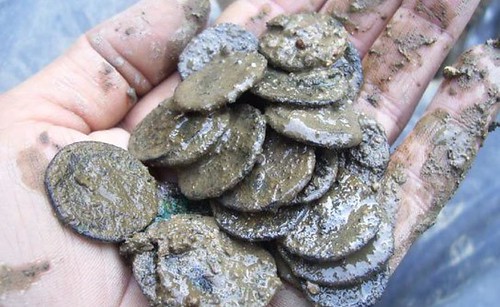
A pot containing some 500 silver and gold coins was found during excavation work near the Dutch city of Vianen. The coins date from the 15th century, RTV Utrecht reports.
The pot of coins was discovered by waterworks employees during excavation work for Hoef en Haag, a new town between Vianen and Hagestein. They immediately contacted Utrecht's archeological hotline, who closed off the area and collected the pot and coins.
Initial investigation by archeologist Peter de Boer revealed that the coins - 12 gold, the rest silver - were hidden in a simple cooking pot made of glazed earthenware. Some textiles were also found in the pot, indicating that the coins were packed in fabric bags or cloths. Most of the coins seem to date from the 1470's and 1480's. Some of the coins show King Henri VI of England, Bishop of Utrecht David of Burgundy, and Pope Paul II.
To read the complete article, see:
15TH CENTURY POT OF GOLD FOUND DURING EXCAVATION NEAR DUTCH CITY
(https://nltimes.nl/2018/03/01/15th-century-pot-god-found-excavation-near-dutch-city)

THE ROYAL MINT'S NEW 10-PENCE COINS
What’s the first thing you think of when you think of Britain?
Tea? An English breakfast? The Loch Ness Monster? A new release of 10-pence coins (roughly 15 cents) has as many answers as letters in the alphabet.
From “Angel of the North” to “Zebra Crossing,” the new coins rolling out this month are a collection of memorable and mundane facts of British life. Some, like B is for “Bond … James Bond” (L is for Loch Ness Monster), may resonate more with people outside the British Isles, while I for ice cream cone may seem more obscure.
“This series really drills down into the heartland of what makes Britain British,” said Dr. Kevin Clancy, director of the Royal Mint Museum, in a statement. “It’s the granularity of British life celebrated on the coinage.”
A public survey was conducted to establish what everyday icons Britons thought represented British lore and life most faithfully. Here are some of their picks.
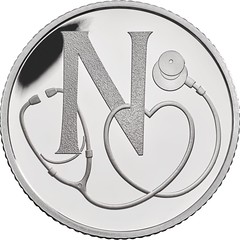
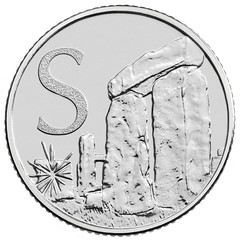
National Health Service and Stonehenge coins
One coin honors the National Health Service, which provides free access to health care for all and turns 70 this year.
Stonehenge beat the White Cliffs of Dover and London’s skyline as the “most famous southern landmark” in the Royal Mint survey.
A is for the “Angel of the North,” a giant male figure with wings spread wide, located near the city of Newcastle, that pays tribute to the recovery of a region after the miners’ strikes of the 1980s.
In this series, however, Q is not for “Queen,” but for “queuing,” also known as waiting in line, which is almost an art form in Britain.
Still, as head of state, Queen Elizabeth II is on the flip side of all the coins.
Dick Johnson adds:
The designs are simple, insipid or even childish. However they might be beneficial for teaching young children the alphabet, Click on the link to the New York Times article to view the picture of all 26 lettered coins. I want to acquire the B coin, B for Bond ... James Bond.
The mints of the world are seeking other series for coins issued for commemorative nature. Ideally a series should have a finite number, preferably less than fifty, and a theme of wide public interest. The U.S. Mint have run through presidents, first ladies, states, national parks and short series in Lincoln cents, and Jefferson nickels.
Here are two questions for E-Sylum readers:
- What more series could be issued by the U.S. Mint?
- What are some of the existing series issued by foreign mints?
To read the complete New York Times article, see:
Q Is for Queuing: Minting British Traditions With New 10-Pence Coins
(https://www.nytimes.com/2018/03/01/world/europe/uk-10p-royal-mint.html)
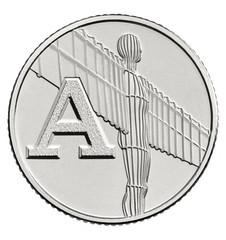 The collection of 26 new 10p designs, unveiled by the Royal Mint, is intended as an A to Z of what makes Britain great – from the Angel of the North to a zebra crossing.
The collection of 26 new 10p designs, unveiled by the Royal Mint, is intended as an A to Z of what makes Britain great – from the Angel of the North to a zebra crossing.
The English breakfast coin depicts a fried egg, bacon, sausages, tomato and beans, while the James Bond coin says: “007”.
Stonehenge, a double decker bus, the NHS and the Houses of Parliament are also celebrated in the collection.
It's released into general circulation from today alongside collectors’ versions available to buy from the Royal Mint website.
And the coin experts said their website crashed this afternoon as people scrambled to get the coins.
The Royal Mint also has a “great British coin hunt” app, allowing coin hunters to create a digital collection of the coins they find in their change.
Users can download the app to scan the coin with their camera.
Some 2.6million coins have been minted – 100,000 for each letter.
Dr Kevin Clancy, director of the Royal Mint Museum, said the new collection is a departure from the standard way in which the Royal Mint has celebrated what is great about Britain in the past.
He said: “We have marked great events, celebrated engineers, politicians and of course royalty.
“This series really drills down into the heartland of what makes Britain British. It’s the granularity of British life celebrated on the coinage.”
To read the complete article, see:
New 10p coin designs REVEALED – Royal Mint website crashes as collectors try to
get them (https://www.dailystar.co.uk/news/latest-news/685586/rare-coin-alphabet-10p-money-collector-news-Royal-Mint)
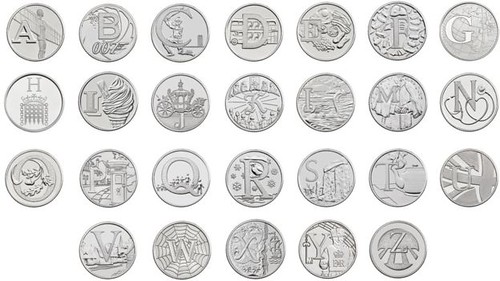
To read the complete article, see:
Old Charles Darwin paper £10 notes out, new 10p coins in (http://www.bbc.com/news/business-43210251)
David Pickup adds:
Although I do not think the designs are very good let's hope that it will lead to a new generation of collectors who widen their interests.
VIDEO: 1940S PHILADELPHIA MINT
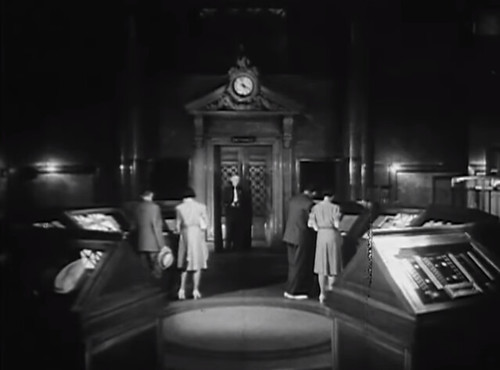
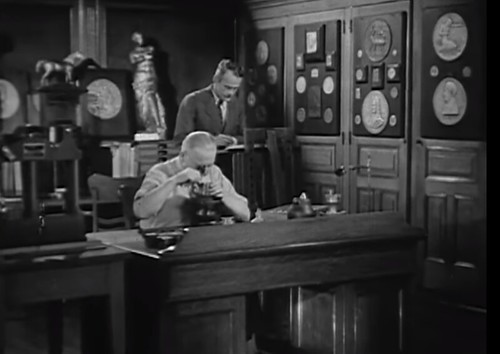
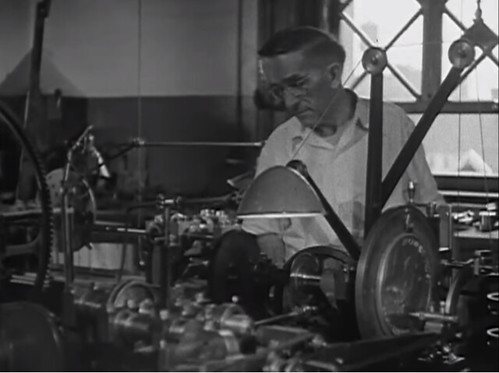
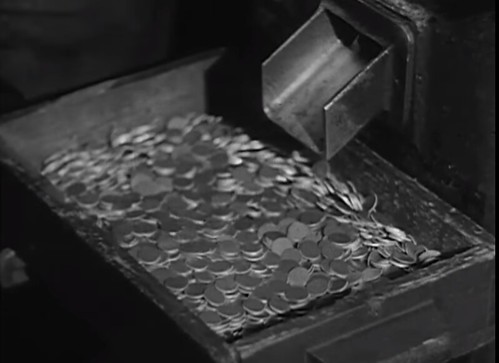
To view the complete video, see:
Minting Coins at the Philadelphia Mint: "How They Make Money" circa 1940 10min (https://www.youtube.com/watch?v=mBjD9N1APsw)
LORD ASHCROFT ACQUIRES SIDNEY DAY VICTORIA CROSS

THE medals of a soldier who was shot six times in the First World War and escaped a bombing raid that destroyed his home in the Second World War have sold for £160,000 at an auction.
The Victoria Cross and other medals awarded to Corporal Sidney Day of the Suffolk Regiment, who survived the Blitz in Portsmouth and is buried in Milton Cemetery, were purchased by the Lord Ashcroft Medal Collection.
A spokesman from Dix Noonan Webb said: ‘This was a strong price for a magnificent Victoria Cross group of medals and associated memorabilia, which came direct from Sidney Day’s family and so had never been on the market before.
‘It was above the £120,000 to £140,000 pre-sale estimate.
‘Dix Noonan Webb is delighted that the medals have become part of the Ashcoft Collection.’
To read the complete article, see:
Medals belonging to Portsmouth war hero sell for more than
£150,000 (https://www.portsmouth.co.uk/news/defence/medals-belonging-to-portsmouth-war-hero-sell-for-more-than-150-000-1-8396883)
For more information on Lord Ashcroft's Victoria Cross collection, see:
LORD ASHCROFT GALLERY: EXTRAORDINARY HEROES
(https://www.iwm.org.uk/events/lord-ashcroft-gallery-extraordinary-heroes)
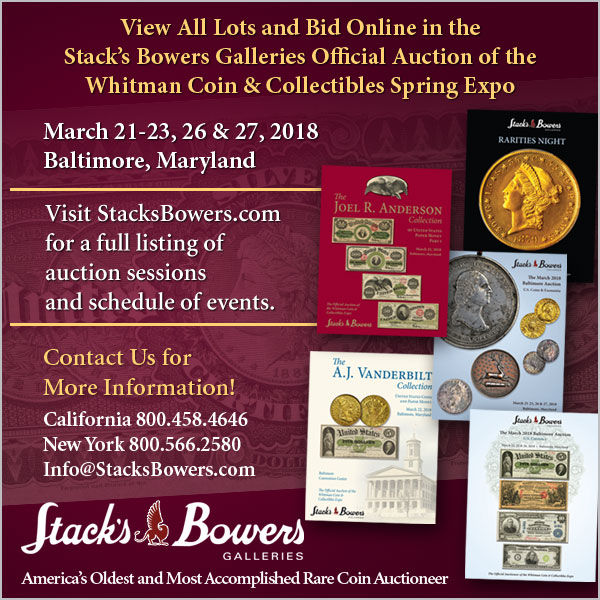
ISRAELI GROUP MINTS TRUMP JERUSALEM MEDAL
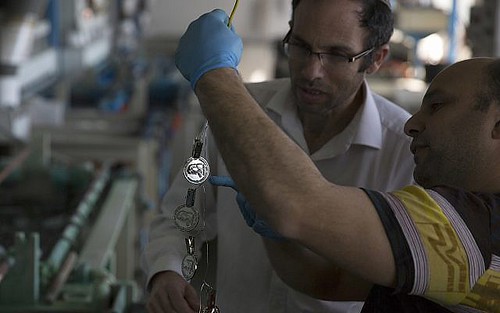
An educational organization focusing on the Jewish Temple said Wednesday it has minted a coin bearing US President Donald Trump’s image to honor his recognition of Jerusalem as Israel’s capital.
The Mikdash Educational Center said the “Temple Coin” features Trump alongside King Cyrus, who 2,500 years ago allowed Jews to return to Jerusalem from their exile in Babylon.
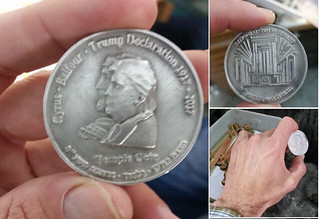 The Trump coin is likely to rile Iranians, who uniformly respect King Cyrus as an ancient Persian hero.
The Trump coin is likely to rile Iranians, who uniformly respect King Cyrus as an ancient Persian hero.
Rabbi Mordechai Persoff of the Israeli group, which also holds activities in the US, said that Trump, like Cyrus, made a “big declaration that Jerusalem is the capital of the holy people.”
His organization minted 1,000 biblical half-shekel coins that can be purchased with a minimum donation of $50. The coin cannot be used as currency.
To read the complete article, see:
Israeli group mints Trump coin to honor Jerusalem recognition
(https://www.timesofisrael.com/israeli-group-mints-trump-coin-to-honor-jerusalem-recognition/)
MOVIE MONEY: THE BANKNOTES OF ZAMUNDA
Gary Dunaier writes:
Fun fact: the paper money from the fictional African nation of Zamunda, from the Eddie Murphy movie Coming To America (1988), was modeled after the pound note shown in the last E-Sylum.
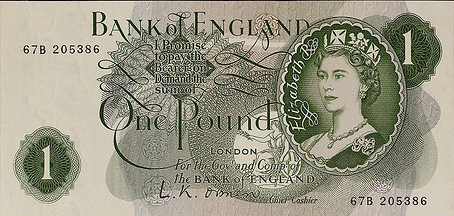
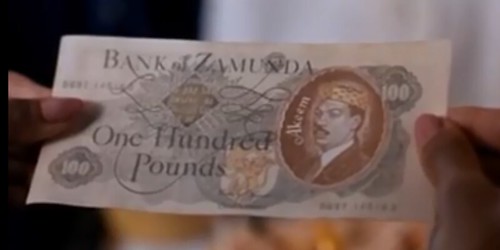
To watch the video (the banknote is at the 0:44 mark), see:
Coming To America - The Boy Has Got His Own Money (https://www.youtube.com/watch?v=pKGd8GAAb00)
To read the earlier E-Sylum article, see:
BRITISH MUSEUM EXHIBIT: MONEY AND MEDALS (http://www.coinbooks.org/v21/esylum_v21n08a22.html)
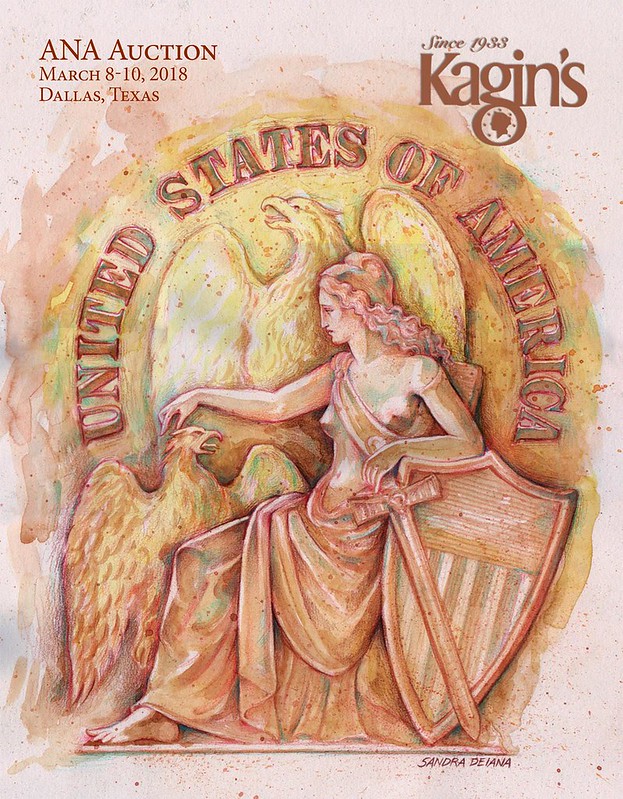
IN OTHER NEWS: MARCH 4, 2018
United States Assay Commission
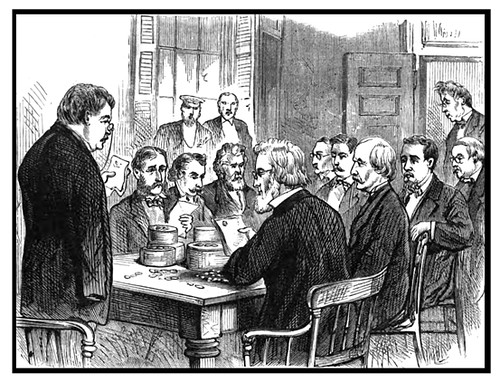
The Assay Commission had tested the quality of our coinage for nearly two hundred years when it was abolished to save a paltry $2,500. It was the oldest operating federal commission and had first met only a few days after George Washington ended his presidency.
The origin of the Assay Commission may be traced to 13th century England. During the reign of King Henry III (1216-1272) it became obvious that some method was needed to control the quality of the coinage issued by a multitude of mints in that country. By 1250 a trial of the pyx was in operation by which samples of coins produced by the widely scattered minters were tested by men specially appointed by the king. (The pyx was simply the box in which the reserved pieces were stored prior to testing.) By the end of Henry’s reign, the trial was formalized as a regular feature of the coinage.
The Trial of the Pyx, as it is known today, is still carried out in Great Britain with style and dignity. Unfortunately in the United States a short-sighted effort to save a few dollars resulted in the end of an honorable institution.
To read the complete article, see:
Assay Commission abolished 1977 (http://www.numismaticnews.net/article/assay-commission-abolished-1977)
Mike Markowitz Interviews David Vagi
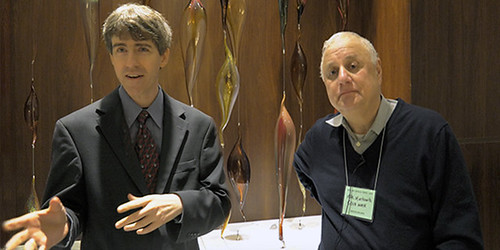
David Vagi (left) and Mike Markowitz
In the following transcription of that interview, Mike asks David about what a grade means on an ancient coin, what the future holds for ancient coin collecting, and what does David have to say about those who think slabbing ancients is anathema to to the hobby…
To read the complete article, see:
Building Museums One Coin at a Time: Mike Markowitz Interviews David Vagi
of NGC Ancients (https://coinweek.com/ancient-coins/building-museums-one-coin-time-mike-markowitz-interviews-davd-vagi-ngc-ancients/)
Famous Faces on Bank of England Notes
Famous faces on bank notes: A brief history (http://www.bbc.com/news/av/business-43171779/famous-faces-on-bank-notes-a-brief-history)
Treasure Hunt Claims a Fourth Victim
A man who died after falling 500 feet in Yellowstone National Park last year was searching for Santa Fe author and antiquities dealer Forrest Fenn’s hidden treasure.
Jeff Murphy, 53, of Batavia, Ill., is the fourth man in the past two years to die while reportedly looking for an antique chest containing gold, coins, jewelry and other rare artifacts that Fenn says he hid somewhere in the Rocky Mountain region in 2010.
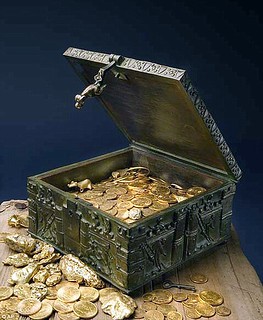 To read the complete articles, see:
To read the complete articles, see:
Santa
Fe author’s treasure hunt claims a fourth victim
(https://www.abqjournal.com/1135807/santa-fe-authors-treasure-hunt-claims-a-fourth-victim-ex-man-who-fell-to-his-death-in-yellowstone-last-year-was-searching-for-the-infamous-antique-chest.html)
FOURTH treasure hunter dies searching for Forrest Fenn's $2m 'hidden cache of gold
and jewels' that the art dealer claims he stashed somewhere in the Rocky Mountains years ago
(http://www.dailymail.co.uk/news/article-5415105/FOURTH-man-dies-searching-Fenns-2m-treasure.html)
To read earlier E-Sylum articles, see:
TREASURE SEEKERS SEARCH FOR AUTHOR'S HIDDEN CHEST (http://www.coinbooks.org/esylum_v18n29a41.html)
AUTHOR'S TREASURE SEARCH BRINGS ANOTHER DEATH (http://www.coinbooks.org/v20/esylum_v20n26a35.html)
Airport Catches Gold Smugglers
A group of South Korean tourists went to painful lengths to avoid tax - by hiding blocks of gold up their rectums.
Seven would-be smugglers, all women in their 50s and 60s, were caught out at customs at Chubu International Airport, Japan, last month when X-rays revealed each of them was carrying at least five metal objects in her abdomen, The Asahi Shimbun reported.
Each block weighed in at some 200 grams.
To read the complete article, see:
Seven women are caught with gold bars hidden in their rectums at Japanese airport
(http://www.dailymail.co.uk/news/article-5416515/Smugglers-caught-gold-rectums-failed-tax-dodge.html)
FEATURED WEB SITE: MINT OF FINLAND
This week's Featured Web Site is the mint of Finland.
www.suomenrahapaja.fi/fin/

